
installation
 聞山海
聞山海
 Evocative of Mountains and Seas
Evocative of Mountains and Seas
2025
Multimedia installation: 10.2 surround sound with 2 synchornised 9K videos, multiple scents
Dimension: 7.2 x 10.8 meters (debut scale)
Original design: 14.2 surround sound, 8x12 meters
Creation and Production Team:
Art Concept: Yin-Ju Chen · Sound Design: Yin-Ju Chen and Cheng Chou · Sound Advisor, Mixing, Execution: Cheng Chou · Scent Advisor and Design: Claire Hūi-hong Âng · Video Effect, Editing, Design and Technical Advisor: Chia-Sheng Lin
複合媒材:10.2 環繞聲道、9K雙頻道同步投影、氣味(天然精油)
尺寸:7.2 x 10.8 公尺(首展規格)
原規劃與尺寸:14.2 環繞聲道、8x12 公尺
創製團隊:
創作及計劃統籌:陳瀅如 • 聲音設計:陳瀅如、周震 • 聲音工程、混音、指導:周震 • 氣味指導與設計:洪慧芳 • 錄像文字、設計、技術指導:林嘉生
Commissioned by Taichung Art Museum 台中美術館委託製作
Evocative of Mountains and Seas will be showing at Taichung Art Museum, Taiwan, from Dec 23 to Apr 12, 2026. Curated by Alaina Claire Feldman

We possess six senses: sight, hearing, smell, taste, touch, and mind. But do we truly need visual cues to perceive? What can stimulate our mental imagery?
My shamanic experiences have shown me that drumming can induce altered states of consciousness, transporting me to mental journeys within the shamanic cosmology. During these journeys to the Lower World, I have encountered spirit animals that have guided and even prophesied to me. I believe these creatures exist, although in different dimensions. My shamanic practice has taught me that closing my eyes can enhance perception.
In Taiwanese folk religion, sound (drumming), text (charms), and scent (incense) are essential elements for invoking spirits, protective entities, and oracles from other dimensions. The title Evocative of Mountains and Seas alludes to this magical process of evocation.
Rather than focusing solely on visual representations of mythical creatures and their environments, Evocative of Mountains and Seas prioritizes sound, scent, and minimal text. The soundscape and the minimalism site design will incorporate sci-fi elements to reflect the unknown realm depicted in The Classic of Mountains and Seas (山海經).
*
《聞山海》(Evocative of Mountains and Seas),延續我一貫的靈性實踐,繼而運用聲響、氣味、文字進行創作,並加入些許超現實、科幻的視聽元素呈現,以反映《山海經》中描繪的未知領域。
試問,我們真的需要視覺線索才能感知嗎?什麼才能刺激我們的心靈意象?如何運用眼、耳、鼻、舌、身、意重新詮釋《山海經》?在運用鼓聲引發意識轉換的薩滿旅程經驗中,我進入了薩滿宇宙觀的「下部世界」,遇到了我的動物靈並與之互動。本人深信這些神獸的存在,儘管祂們處於不同的維度。再者,在台灣民間信仰中,聲音(敲打銅鑼)、文字(符咒)和氣味(上香)是召喚其他維度的神靈、守護神和神諭的重要元素。
最新計畫《聞山海》便暗示了這種神奇的召喚過程。
 致幻記 III:2-19-20
致幻記 III:2-19-20
 Notes on Psychedelics III: 2-19-20
Notes on Psychedelics III: 2-19-20
2021Mixed Media: Red light effect, binaural beats, FRP sculpture, single channel videos, water, charcoal drawing
Archival footage of the moon phases: NASA's Scientific Visualization Studio
Sound effect design: Seismic Sound Lab. Ltd.|Cheng Chou
Animation: FREEMANFREERUN|Lin, Chia-Sheng
Sculpture advisor and sculptor: Glorious Golden Art |Lin, Kuo-Wei and Chen, Wei-Yu
複合媒材:紅燈光效、雙耳錯聽頻拍、FRP雕塑、單頻道錄像、水、炭筆素描
月亮檔案片:美國國家航空暨太空總署科學視覺化工作室
聲音設計:周震聲音設計|周震
動畫設計:自由氏視覺創意有限公司|林嘉生
雕塑顧問、FRP翻模:金耀點金藝術有限公司|林國瑋、陳威宇
please use headphones for the best sound performance for the video documentation.
| The red light will increase or decrease as the sound effect changes.
室內紅光會隨著音效變化而增減 |
|
In art, we always prize the pursuit of intellectual insight. From subject matter to the questions that manifest themselves in materials, a work's vocabulary is inseparable from its meaning. In 2015 Yin-Ju Chen began to study altered states of consciousness – "ordinary" and "non-ordinary" states of consciousness, the "subconscious" and the "unconscious" – studying with shamans to learn the process and mindset of altered consciousness as the basis for her art. Notes on Psychedelics (2015) considered how a drug (DMT) conveys our consciousness to an unknown spiritual dimension. In Notes on Psychedelics II: Inside a Memorable Fancy (2018-2019), the artist used her personal experiences of shamanism to reference and document an individual's altered states of consciousness, revealing a fantastical, inscrutable, mysterious "journey" and presenting the transcendental experience of shamanic ritual.
Notes on Psychedelics III: 2-19-20 continues the depiction of altered consciousness in this series of works. Unlike works produced around visual symbols and concepts, it reveals the artist's past clairvoyant experiences and dream notes, and from them it extracts images, creating scenes that shift between dreams and consciousness, exuding an atmosphere of mysticism reminiscent of occult rituals, when shamans become possessed and enter an indistinct, oblivious state. Here, consciousness serves as a vehicle for the source of many insights into life, the universe, time and space, and it leads us to accept the guidance of a higher form of life. When we enter the space that Yin-Ju Chen has arranged, soundwaves trigger our perceptions, ushering us into an experience that is real yet transcends reality. Next, the dim lighting in the room brightens, opening a space of complex ambiguity. All these actions always take visitors to unexpected places, where they linger and wonder what will happen next. This is quite thought-provoking. But they must first think about what they encounter by accessing their senses, and let their mind and body sink into the experience.
Yin-Ju Chen's space of images formed by sound, lights, objects, drawings and videos generates an abstract, spiritually animated world. They are the "dreams" that exist within consciousness. She believes that dreams from the depths of our consciousness can awaken both our minds and our souls. On the surface these mirages seem fragmentary and scattered, but they open up a broader dimension in the human state of consciousness, and in the mind of the artist they serve to create a level of inner perception. In this work, external things shatter our customary mindset. These highly psychedelic techniques are an attempt to induce the visitor’s powers of sensory perception, putting them in a state of excitement, paralysis, rapture or quiescence, and thus enter a deeper mental dimension where consciousness and dreams run free within our emotive sensations. Yin-Ju Chen focuses on the hidden spiritual abilities of people in modern society. She uses the language of mental images to manifest a spatial topography, constructing an oblique "scene" and revealing an "other" space to express a certain hidden mindfulness that is innate in human beings. At this moment, this work touches an unpredictable realm of imagination, embedding the immaterial within material reality, in an attempt to reconfirm the ultimate pure land of the soul that we hope to preserve.
文/蕭淑文
在藝術裡,我們始終關注的是知性的追尋。從主題到材料體現的問題,作品的語彙和它的意義密不可分。自2015年,陳瀅如開始研究意識轉換─「尋常 意識」、「非尋常意識」、「潛意識」、「無意識」, 並通過薩滿學習意識轉換的過程與思考,作為她創作基礎。〈致幻記〉(2015)觸及藥物(DMT)把我 們的意識帶到一個未知的精神維度。〈致幻記 II: 刻幻象〉(2018-2019)藝術家以親身經歷之巫儀經驗作為參照紀錄個人的意識轉換狀態,揭露其中奇幻難懂的奧秘「旅程」,呈現薩滿儀式中的超覺經驗。
〈致幻記III : 2-19-20〉延續其系列作品關於意識轉換的描繪。不同於圍繞著視覺符號和觀念生產的作品,它透露過去藝術家的靈視經驗與夢境筆記,並從中提煉意象,創造出在夢境和意識之間轉換的場景,散發出一種神祕主義的氛圍。如同巫祭儀式,巫師在神靈附體時,進入一種忘我的迷離狀態。在這裡,意識是承載諸如生命觀、宇宙觀、時空觀的源頭,它引領我們接受一種更高生命的指引。當我們走入陳瀅如部署的空間,聲波啟動我們的知覺,讓我們經歷一種真實但超越現實的經驗。接下來,房間裡的燈光從暗到亮,撬開一個複象多義性空 間。這一切運作,讓觀眾總是在他們意想不到的地方發生,他們待在那裏懷疑著會發生什麼事件,相當耐人尋味。但眼前,他們必須先通過感官來思考,讓他們的精神與身體沉淪其中。
陳瀅如的意象空間以聲音、燈光、物件、素描及影像,營造出抽象的靈動世界,它們是存在於意識裡的「夢」。她相信從屬於深層意識中的夢境,能把我們的神經和心靈一併喚醒。表面上看似瑣碎散亂的幻象,但它們開發了人類意識狀態中另一個更為廣闊的維度,在藝術家心裡用以創造一個內在的知覺層次。這個作品,外在的東西打破我們慣常的智性,這些展現一種更具迷幻的手法,企圖誘發觀眾的感應力,使他們處於亢奮、麻痺、著魔、停頓狀態中,以此進入更深層次的精神向度,讓意識和夢境在感性中奔馳。陳瀅如聚焦在文明社會中人被隱蔽的心靈能力,她用意象語言體現空間形貌,建構一個隱晦不明的「場景」,揭顯「另一個」空間表達人與生俱來的某種深藏的意識思維。此時此刻這個作品觸及關於想像和不可測的界域,將非物質嵌入物質現實中,試圖再度辯證我們想保存最後的心靈淨土。
"Look for her." "She dreamt about you." |
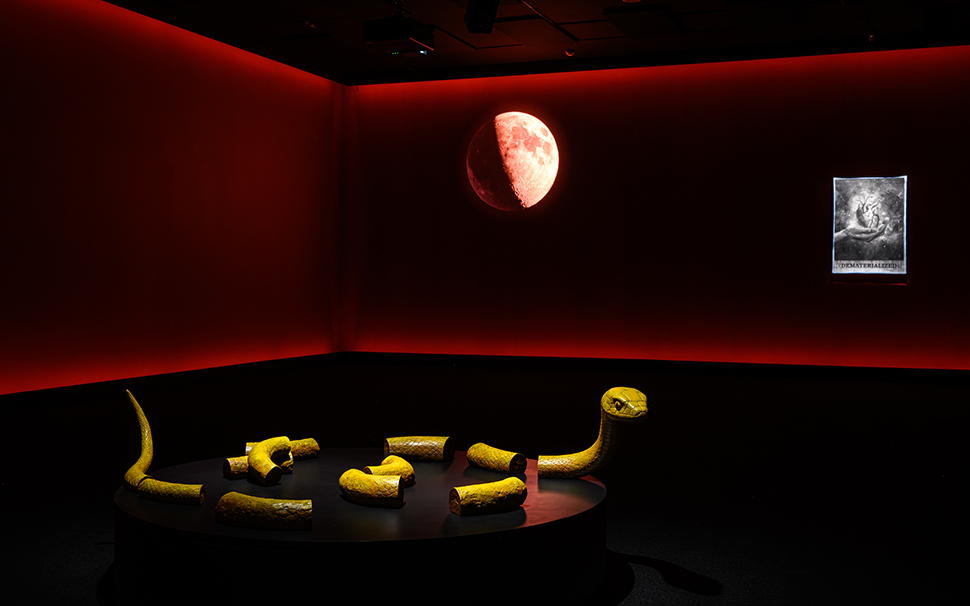 |
2021 Notes on Psychedelics III: 2-19-20 //// 2018-2020/ Sonic Driving //// 2018/ Reverberation of the Pleiades //// 2018/ Extrastellar Evaluations III : Entropy : 25800 //// 2016/ Extrastellar Evaluations //// 2015/ Notes on Psychedelics //// 2015/ Action at a Distance //// 2014/ Liquidation Maps //// 2013-2014/ As Above, So Below //// 2012/ One Universe, One God, One Nation //// 2011/ The Turner Archives

 Sonic Driving
Sonic Driving
2018-2024
commissioned by the 13th Gwangju Biennale and V-A-C Foundation
watercolor drawings, video, 7.1 surround sound
Sound design: Cheng Chou
Animation: Chia-Sheng Lin
第13屆光州雙年展、V-A-C基金會委託製作
水彩|鉛筆素描|錄像|7.1 環繞聲道
聲音設計:周震
動畫合成:林嘉生
*The displaying objects have been modified in 2024
*備註:陳列物件於2024年刪除更動
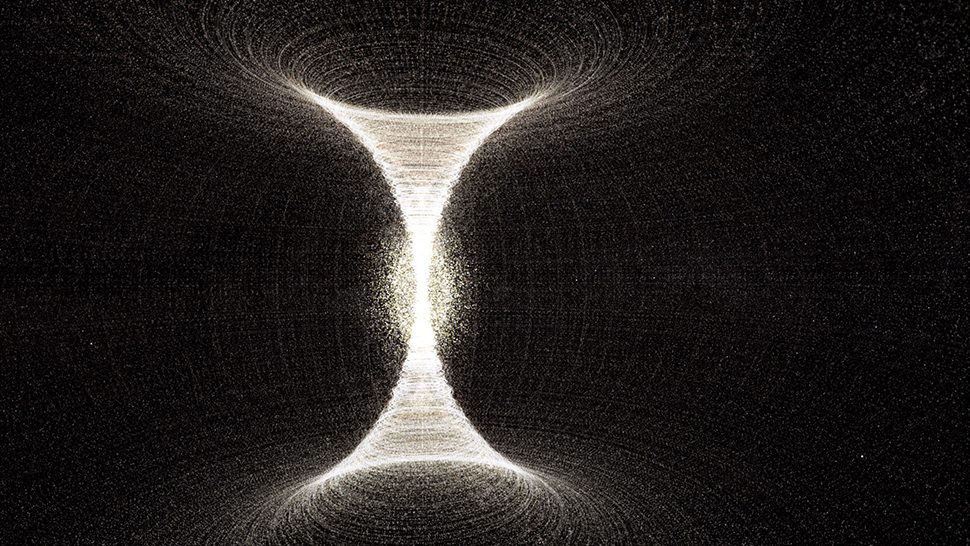
| …the ubiquity of these practices across time and space in human history suggests that altered states of consciousness play a fundamental role in the maintenance of human social fabric and human social-spiritual linkage.1 |
Sonic Driving not only explores the capacities of our brain, consciousness, and altered states of consciousness (ASC), it also "previews" the future of humanity, and questions the mad house of rationality via the methods of "Core Shamanism."2
***
In our rational, material and modern society, scientists continue to investigate the mysteries of human consciousness. However, we have already found many possible answers in our ancient traditions: shamanism or in Chinese, "Wu" (巫). For shamans, our ordinary consciousness is not the only consciousness we have, and our visible world is not the only world that exists. Shamans expand or alter their consciousnesses to enter to the spiritual worlds for various purposes -- mostly to heal people.
Sonic Driving visualizes this tripartite reality: the shaman’s upper world (video), middle world (drumbeat sound), and lower world (drawings).
***
In the ancient times, shamans were the healers and sometimes leaders of their tribes and communities. Their predictions and skills at communicating with spirits determined the survival of their tribes.
Following this path, in Sonic Driving, we journey to the other world, by shamanic drumming technics, and ask the spirits for guidance on the way toward the future of humanity.
***
From historical evidence found in the Blombos Cave of South Africa, the history of ASC dates back to 70,000 to 100,000 years. Researchers have found the evidence of ASC worldwide. Even though "getting into a trance" is intangible, it is very likely that the ancient cave paintings which often resembles half animal and half human figures came from an ASC vision induced in shamanic rituals.
***
Why the Shamanic way?
Because it works.
//YJC, 2019, Taipei
「…這實踐在人類歷史上跨越時空且無所不在,意味著意識轉換在維護人類社會結構以及精神聯繫上起了根本的作用。」1
《Sonic Driving》 不僅僅探索我們的大腦、意識、儀式轉換等潛能,這件創作計畫同時「預覽」人類的未來,以及透過「核心薩滿」2的方法對狂妄的理性主義提出疑問。
***
在我們理智的、物化的現代社會,科學家持續地研究人類意識的奧秘。然而我們已經在古老傳統中找到許多可能的答案:薩滿實踐,或是華人的「巫」文化。對薩滿或巫師來說,我們的尋常意識並非我們擁有的唯一意識狀態;我們可見的是世界也非唯一存在的現實。薩滿們基於種種理由,擴張或是改變她們的意識,進入靈性的世界,大部分的目的是療癒他者。
《Sonic Driving》將薩滿的宇宙觀視覺化:運用錄像呈現呈現上部世界的旅程、中部世界的薩滿鼓聲、以及下部世界的繪畫日誌。
遠古時期,薩滿的角色是部落的醫者,甚至是領袖。他們的預知能力與靈魂溝通的技能,決定了部落的生存。
***
就南非發現的布隆伯斯洞窟的證據來看,意識轉換的歷史可追溯到七至十萬年前。研究人員也已在世界各地找到找到了意識轉換的證據。即便「進入恍神狀態」是不可觸知且難以明瞭的,但那些半人半獸的洞穴壁畫有極高的可能性是在薩滿儀式中,經由意識轉換後導出的視覺紀錄。
***
為何選擇薩滿途徑?
因為有效。
//YJC, 2019, Taipei
1. Ember, Carol R., Carolus, Christina. 2017. "Altered States of Consciousness" in Explaining Human Culture. Human Relations Area Files
2. "Core Shamanism consists of the universal, near-universal, and common features of shamanism, together with journeys to other worlds, a distinguishing feature of shamanism. As originated, researched, and developed by Michael Harner, the principles of Core Shamanism are not bound to any specific cultural group or perspective." The Foundation for Shamanic Studies. <https:// www.shamanism.org/workshops/coreshamanism.html>
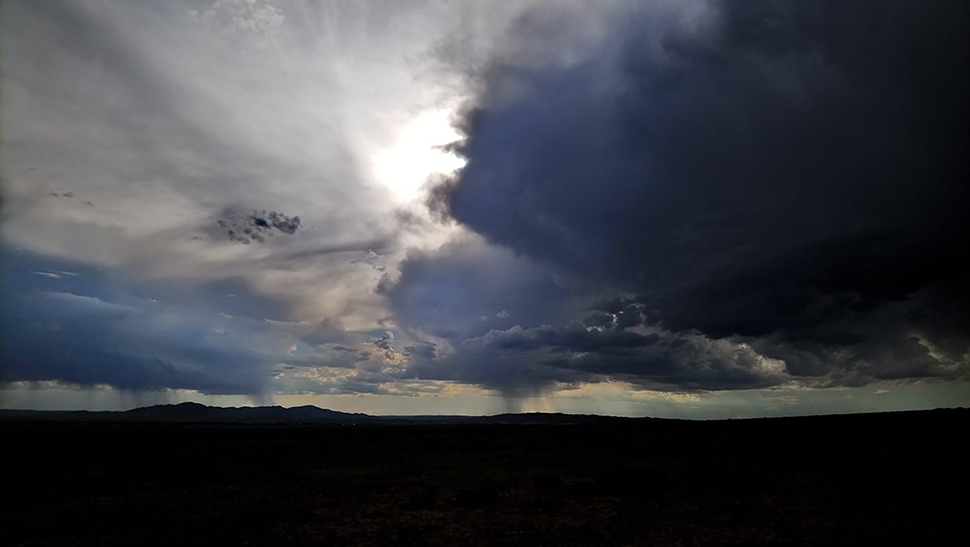
Shamanic ritual drumming induces an altered state of consciousness and has historically served the purposes of social cohesion, grief, and healing in diverse indigenous and communal settings. The mapping of mental journeys while immersed in acoustic pulsation and deep meditation is rarely attempted, but in her project, Yin-Ju Chen dives into the knowledge of drumming techniques to study traditional forms of spirituality. Deeply engaged with visualizations of extracorporeal journeys in mystical territories and cosmic visions of intangible realities that extend far beyond the boundaries of conventional mind-body relations, her explorations probe the thresholds of consciousness.
Sonic Driving questions the madhouse of rationality via the methods of "core shamanism" that were originated, researched, and developed by Dr. Michael Harner. With repetitive drumming, the work visualizes a tripartite collective reality: the upper world appears in video footage shot in Mongolia and Lake Baikal, evoking a world where the Tengri, the chief deity worshipped by Turks, Mongols, and Magyars across the Central Asian steppe, made human beings who at first lived happily and knew neither suffering nor sickness. The middle world, channeled through a tunnel of reverberations, is the dimension in which "right" and "wrong" emerge and humans coexist with ghosts, ancestors, and spirits. The lower world is portrayed in luminous drawings of a journey into the realm of animal wisdom. Sonic Driving not only sheds light on the possibilities of self-experience and the subjective demarcation of the self from others and collective reality but also shares insights into the future of humanity through the consultation and guidance of oracular spirits. In an age when subjectivities are formed through globalized digital technologies, this work corresponds with sacred intelligence between worlds.
![]()
文/德芬阿亞思(Defne Ayas)
薩滿鼓聲誘發的意識轉換,歷來在原民社會與公共領域具有社群凝聚力、共苦、療癒的意圖。但沈浸在聲響脈動與深度冥想的心靈旅程之映射,卻是極少的嘗試的,然而陳瀅如的計畫卻潛心研究鼓聲知識,進而習之傳統的靈修方法 。她探測意識的門檻:在神秘領域與宇宙願景等無形世界中,遠遠超越傳統定義的身心關係的界線,深深地投入超體經驗的旅程,並將之視覺化。
《Sonic Driving》運用源自麥克漢納博士研究發展的「核心薩滿」作為方法,對狂妄的理性主義提出質疑。伴隨規律的鼓聲,這件作品將三方集體真實視覺化(編譯:薩滿宇宙觀中的三部世界):上部世界的影像拍攝於蒙古與貝加爾湖,喚起橫跨中亞草原,土耳其、蒙古、瑪札爾人共同崇拜的騰格里,一位初始讓人類快樂生活,不知痛苦與疾病為何物的天神。中部世界,穿越殘響隧道,來到對錯分明的維度,以及與鬼神共存的人類世界。下部世界具啟發性地彩繪著進入動物智慧的領域中。《Sonic Driving》不僅揭示了自我體察、人我劃分與集體真像的可能性,同時也通過神諭的指導,分享對人類未來的洞察。在全球數位科技作為主體的時代,這件作品呼應著不同維度世界的智慧。
is portrayed in luminous drawings of a journey into the realm of animal wisdom.
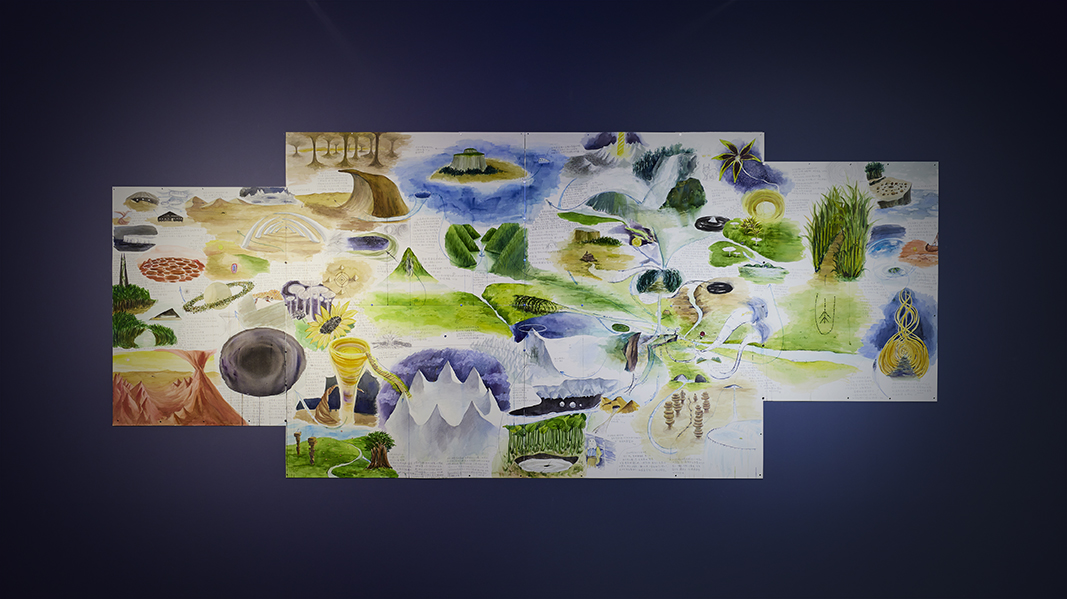
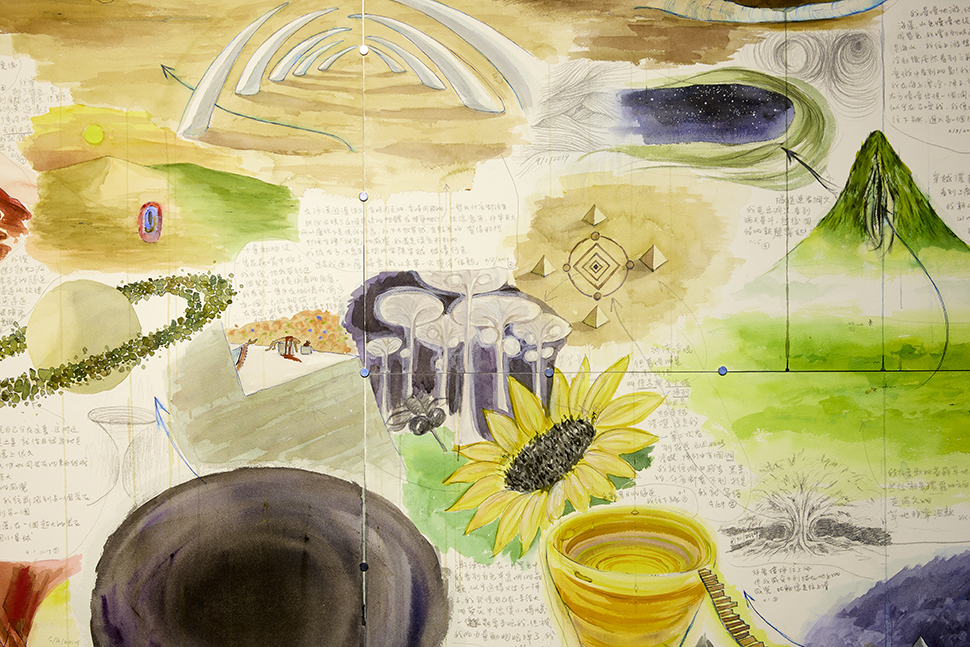 |
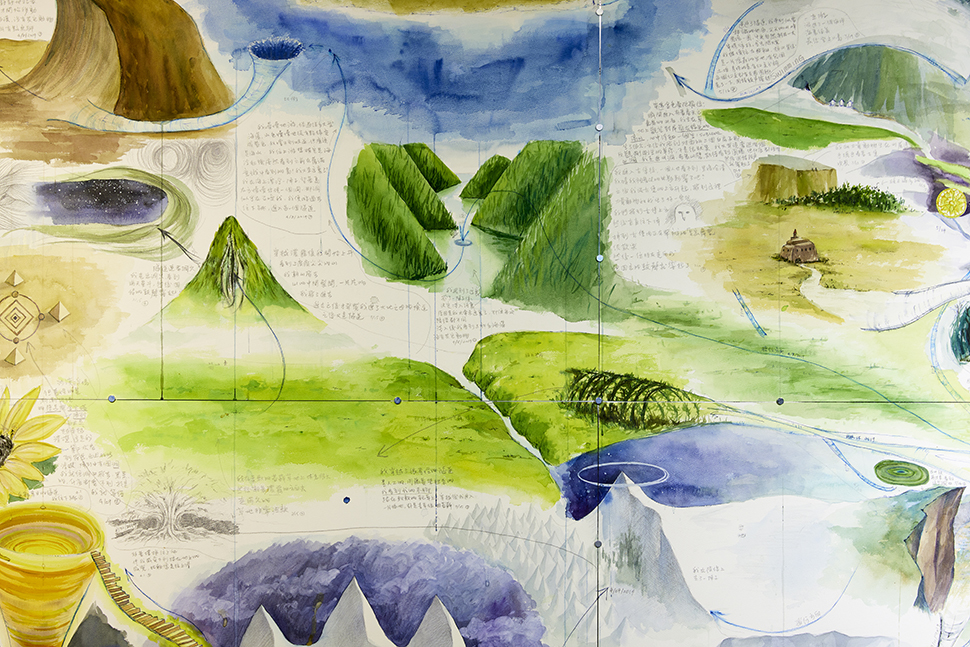 |
The upper world video (HD video, 15’02”, color, Blu-ray, 7.1 surround sound) is about two intertwining journeys: the tiring pilgrimage to Mongolia and Siberia, and the shamanic journey to the upper world.
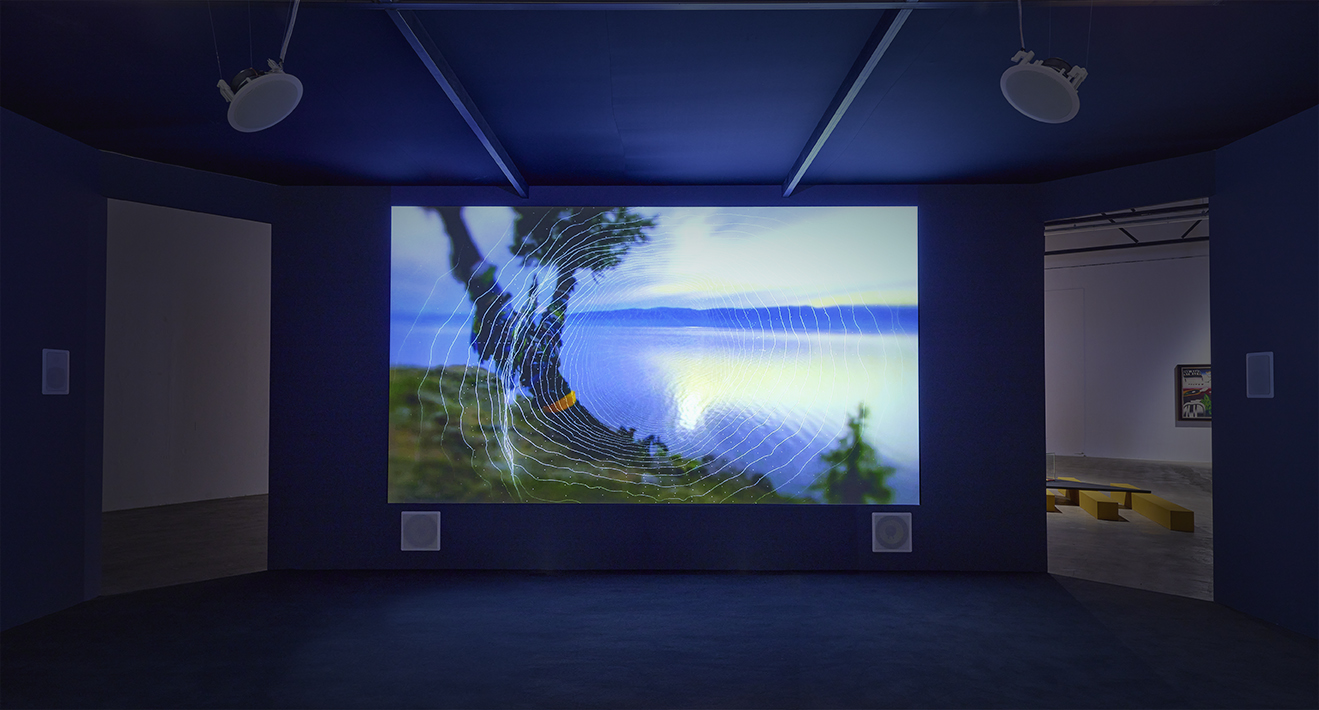
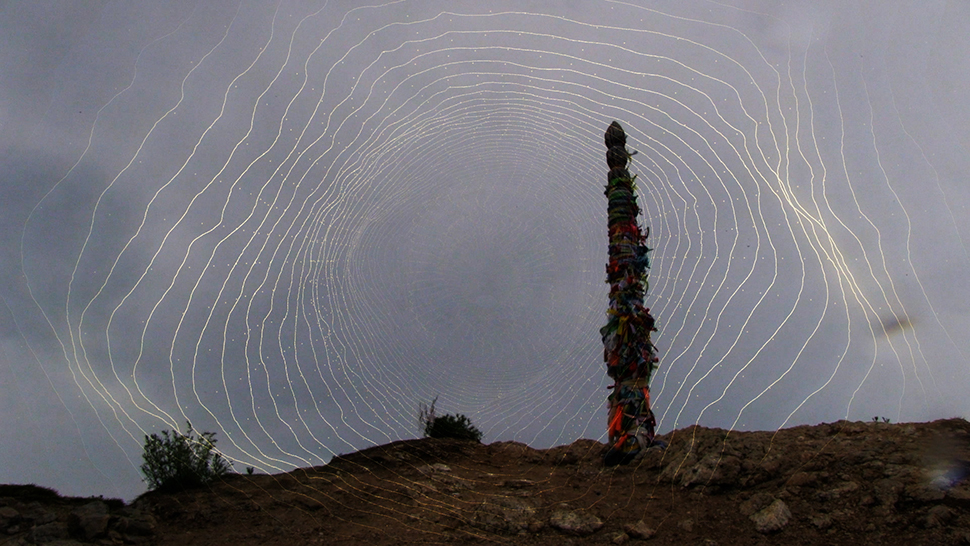
Video still
is represented as shamanic drumming (recorded in 7.1 surround sound, embedded in the upper world video),
and the workshops.
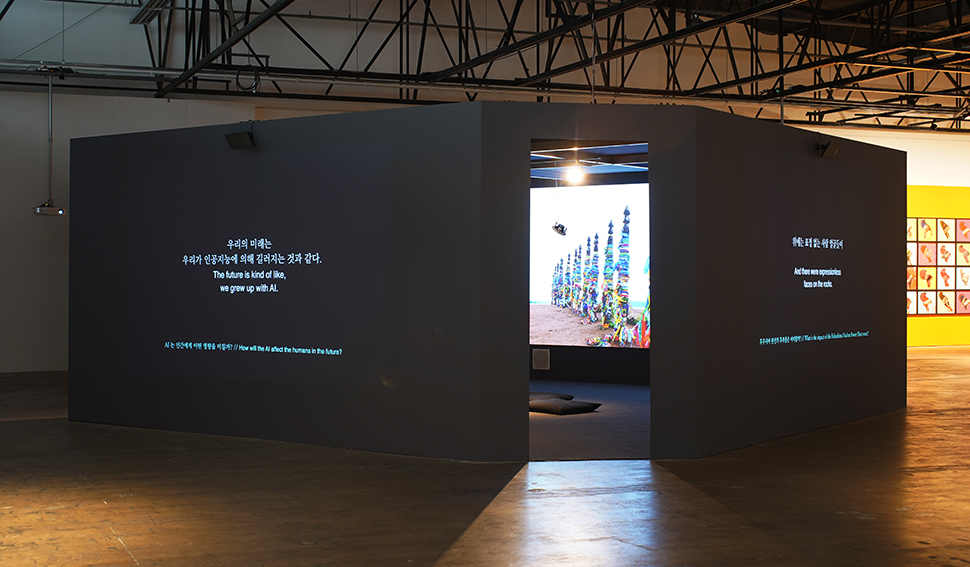
Courtesy: Minds Rising, Spirits Tuning, The 13th Gwangju Biennale | Photo Credit: Sang Tae Kim
2021 Notes on Psychedelics III: 2-19-20 //// 2018-2020/ Sonic Driving //// 2018/ Reverberation of the Pleiades //// 2018/ Extrastellar Evaluations III : Entropy : 25800 //// 2016/ Extrastellar Evaluations //// 2015/ Notes on Psychedelics //// 2015/ Action at a Distance //// 2014/ Liquidation Maps //// 2013-2014/ As Above, So Below //// 2012/ One Universe, One God, One Nation //// 2011/ The Turner Archives

 昴宿星團回聲器 Reverberation of the Pleiades
昴宿星團回聲器 Reverberation of the Pleiades
2018Land art project | Kunstfort bij Vijfhuizen | The Netherlands
A ton of calcite crystals, a ton of white stones
地景藝術|Vijfhuizen藝術碉堡|荷蘭
一公噸方解石水晶、一公噸白石頭
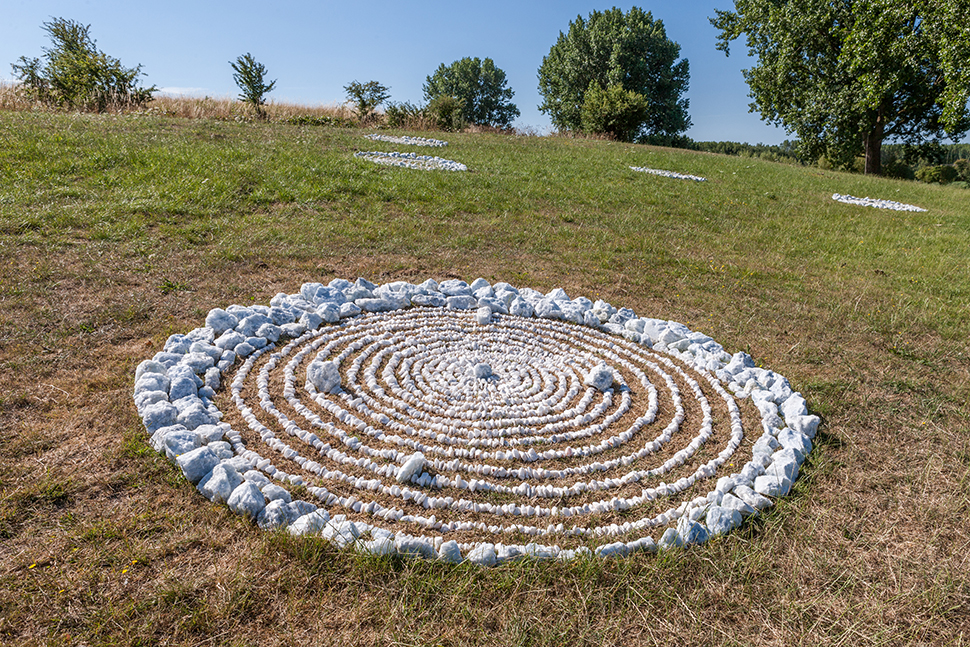
Photo credits: © Maarten Nauw/ Kunstfort bij Vijfhuizen
 |
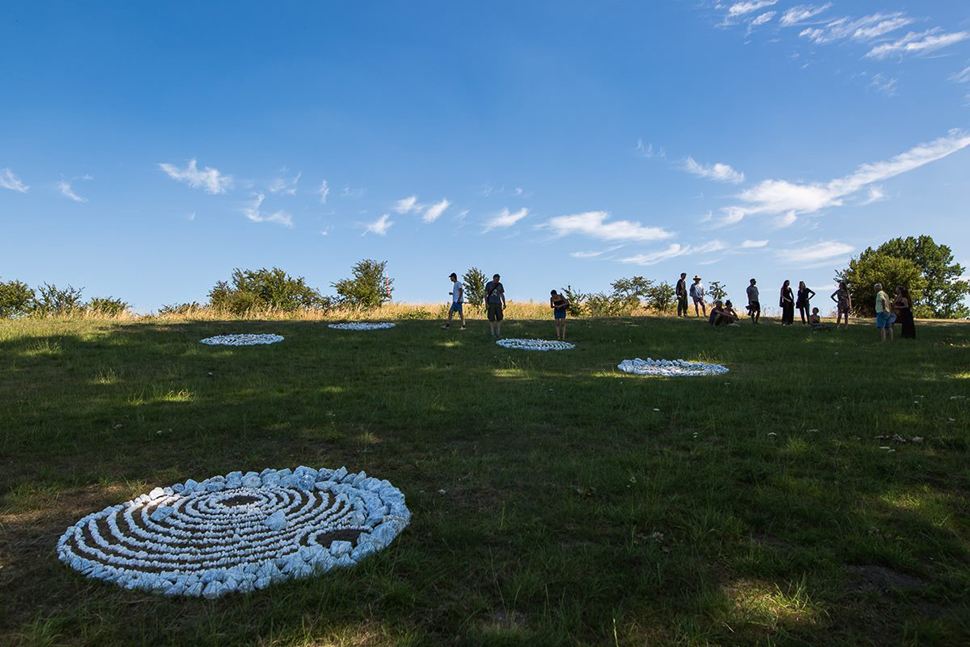 |
Kerstin Winking
In what ways do the stars affect human life on Earth? Yin-Ju Chen searches for answers to this question in cosmology, conspiracy theories and philosophy, all of which inspire her artistic practice. American art of the 1960s and archaic patterns based on star constellations and found in global cultural productions, reverberate in Reverberation of the Pleiades, her new land art work created as part of "The Mindful Intervention" at Kunstfort Vijfhuizen.
Reverberation of the Pleiades is culturally anchored in the global human tradition of depicting and describing the Pleiades, a star cluster that came into being about 100 million years ago. The Pleiades are for instance mentioned in Homer’s Iliad and depicted on the Nebra sky disk. Astronomers say that the Pleiades star cluster is anchored in a deep past and it will last into the far future for about another 100 million years before it fades. In view of this time span, Yin-Ju’s Reverberation of the Pleiades reads like a contemporary reminder of the ephemerality of human life.
2021 Notes on Psychedelics III: 2-19-20 //// 2018-2020/ Sonic Driving //// 2018/ Reverberation of the Pleiades //// 2018/ Extrastellar Evaluations III : Entropy : 25800 //// 2016/ Extrastellar Evaluations //// 2015/ Notes on Psychedelics //// 2015/ Action at a Distance //// 2014/ Liquidation Maps //// 2013-2014/ As Above, So Below //// 2012/ One Universe, One God, One Nation //// 2011/ The Turner Archives

 超星鑑定 III:熵:25800
超星鑑定 III:熵:25800
 Extrastellar Evaluations III : Entropy : 25800
Extrastellar Evaluations III : Entropy : 25800
2018
Solo exhibition | Installation view | TKG+ Projects | Taipei
Installation objects including: 2 videos, 2 sets of drawings, site-specic vinyl cuts
個展展場記錄照片|TKG+ Projects|台北
兩個影像投影、兩組素描、限地製作卡點西德圖文
|
Man models the Way of earth; earth models the Way of heaven; heaven models the Way of Tao; Tao models the Way of nature. - Tao Te Ching |
Extrastellar Evaluations III : Entropy : 25800 is a continuation chapter of the "Extrastellar Evaluations series" that first began in 2016. This project contemplates human civilization and humanity’s future through an investigation of space physics, extraterrestrial myths, and cosmography.
By using hypotheses and prophecies founded upon a choreography of fragments of history, as well as mass media imagery and information, eponymous video Extrastellar Evaluations III : Entropy : 25800 attempts to reveal when exactly doomsday takes place. This video further adapts the notion of "entropy" from the second law of thermodynamics, and connects it to the avarice and belligerence of human nature. Interspersed in the video are the narrations of a non-human intelligence named "Ra" concerning that everything is the distortion of the one infinite Creator.
《超星鑑定III:熵:25800》(以下簡稱《超星鑑定III》) 延續自2016年開始發展的「超星鑑定」系列的敘事軸線, 經由探討太空物理、外星傳說、宇宙誌來反思人類文明與未來。 與個展同名的影片《超星鑑定III》利用破碎的歷史、新聞與歷史影像重新演繹,以假說預言,並進而推展對未來的想像。片中以春分點完整繞行黃道一周的時間,來揭示末日的時間點。 陳瀅如並進而挪用熱力學第二定律中的不穩定變因「熵」,隱喻宇宙「熵」值的變動與人類社會貪婪與好戰的微妙關係。影片中交錯出現外星生物Ra所述說著的 「太一」的訊息,並疊合著人類引發的戰爭、禍亂之歷史影像,逐步邁向眾多科學家、天文學家預言的宇宙終極命運:能量終將耗竭,未來再也無法產生運動與生命。
International Film Festival Rotterdam 2018 Official selection
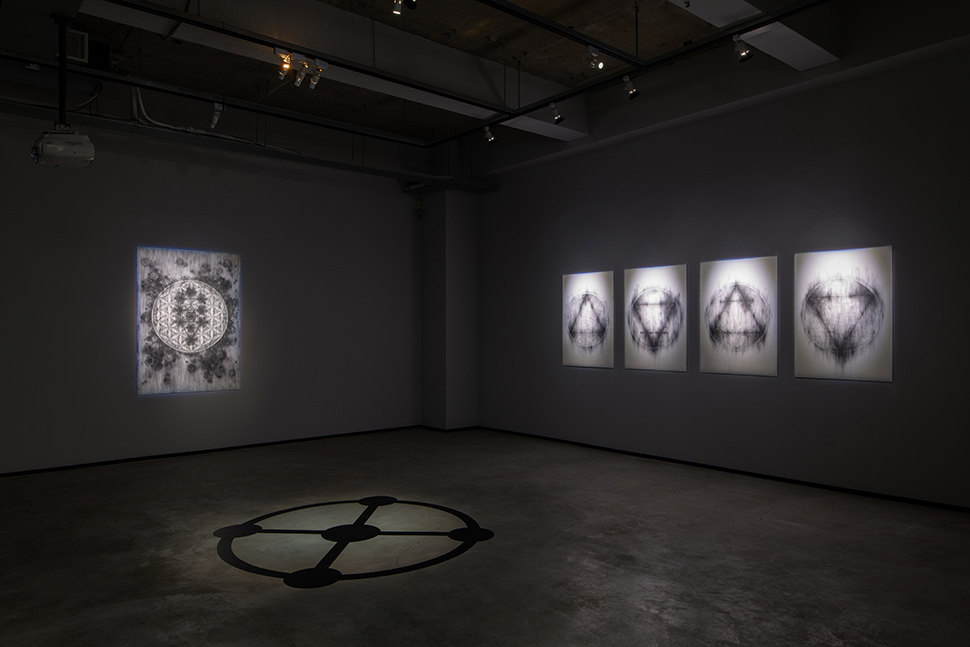
個展展場記錄照片|Installation view | TKG+ Projects | Taipei
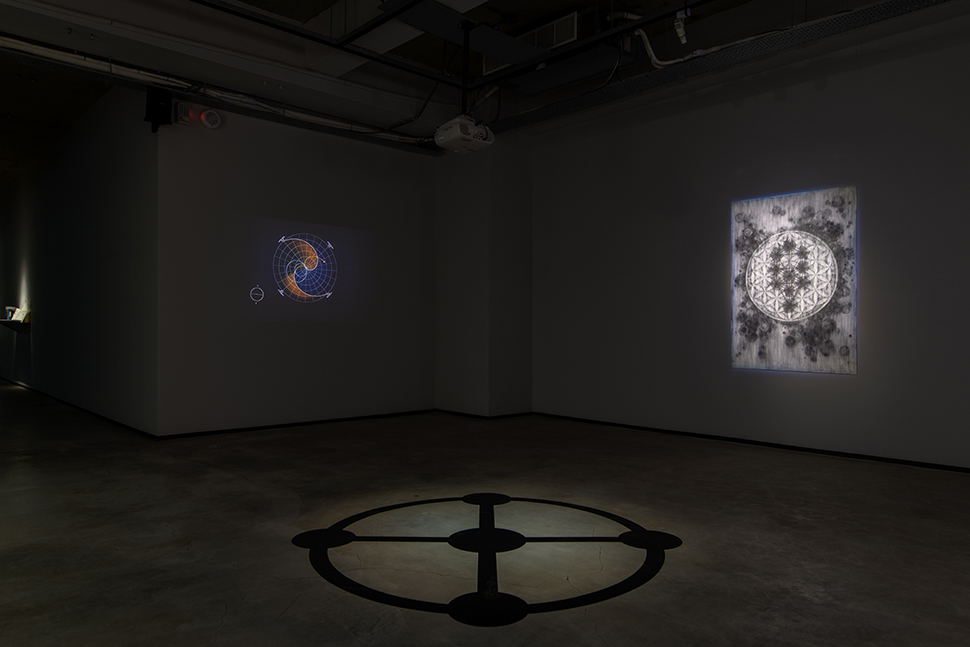 |
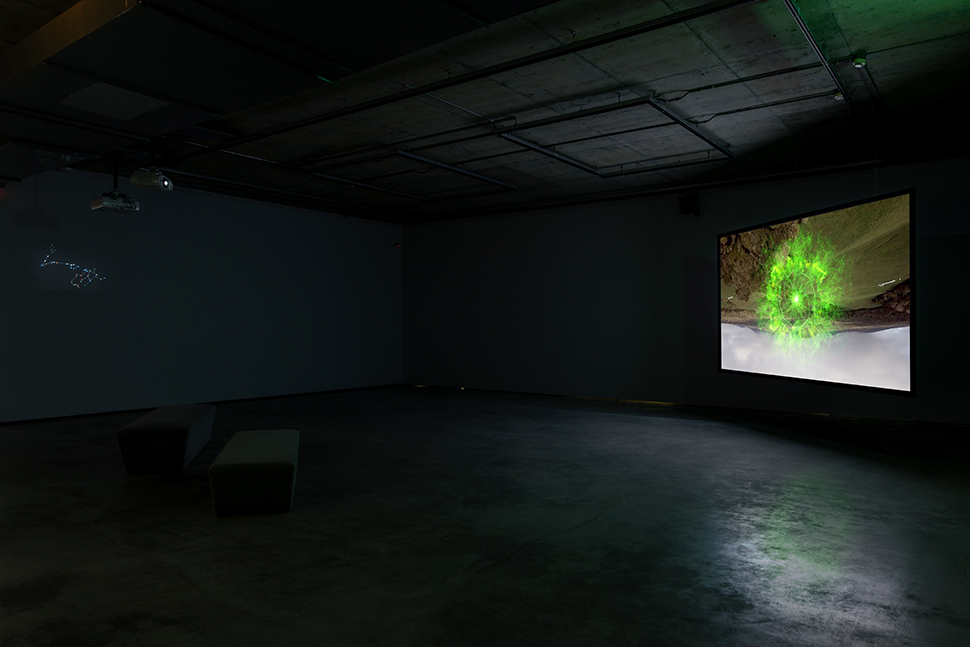 |
晷舞 / Sundial Dance | 60" | animation | color | no sound | 1080p HD | 24p|2018
above video is a 30 sec sample
動畫:林嘉生|animation: LIN Chia-Sheng
Dystopia or, an allegory of (counter-)evolution
Rikey Tenn
| "The future is but the obsolete in reverse." In a rather round-about way, many of the artists have provided a visible analog for the Second Law of Thermodynamics, which extrapolates the range of entropy by telling us energy is more easily lost than obtained, and that in the ultimate future the whole universe will burn out and be transformed into an all-encompassing sameness.1 ── Robert Smithson |
Artist Robert Smithson, who created the 1970 earthwork sculpture Spiral Jetty in Salt Lake City, Utah, U.S., once wrote an essay titled "Entropy and the New Monuments" for Artforum magazine that was subsequently included in the book "Robert Smithson: The Collected Writings" published in 1996. In this essay, he conveyed through the second law of thermodynamics established in the 19th century, a scenario widely accepted among artists of the time that energy loss far exceeds its acquisition in the universe, leading to an inevitable future of total and pervasive stillness — the so-called "heat death of the universe." Hence, artists were devoted to monuments that transcended time. However, his writings seem unsentimental regarding the end of the universe; rather, he hints at human expressions toward the coming of the possible end of days.
The structure of Smithson's Spiral Jetty coexists with nature. In his essay he mentions a number of artists active in the 1960s who also applied methods from the natural sciences to create new monuments that seem to "cause us to forget the future." The time it takes to decay or to biologically evolve is completely eliminated in the monuments created by these artists. This temporal offset also abolishes values attributed to the notion of action in art — "Reaction follows action, till finally the artist gets 'tired' and settles for a monumental inaction." He goes as far as to declare "the awareness of the ultimate collapse of both mechanical and electrical technology has motivated these artists to build their monuments to or against entropy.2"
Looking back from the vantage point of the 21st century, though the "inaction" inspired by entropy temporarily escapes temporality, the "heat death of the universe" has become a prophesy perpetually delayed by the newest theories on the formation of the universe. At the same time, the so-called new monuments of these artists always lead to thoughts of recent scientific discoveries such as simulations of crystalline structures of minerals and nature's geometric forms, or the momentary bursts of electro-optical energy. This confusing paradox also echoes the rumored end of the "Age of Pisces" in the North American social atmosphere, while a mass media infested with conspiracy theories conveys its desires for the "Age of Aquarius." Is this the fate of technology-inspired art, or an inevitable outcome of the highly pressurized Cold War era?
| Recently, there has been an attempt to formulate an analog between "communication theory" and the ideas of physics in terms of entropy. As A.J. Ayer has pointed out, not only do we communicate what is true, but also what is false. Often the false has a greater “reality” than the true. Therefore, it seems that all information, and that includes anything that is visible, has its entropic side3. ── Robert Smithson |
For the first time, an eponymous film in Yin-Ju Chen's latest solo exhibition "Extrastellar Evaluations III: Entropy: 25800," links the abovementioned Second Law of Thermodynamics with the cycles of the Great Year (the period of one complete cycle of the spring equinox around the ecliptic), contents of "the telepathic communication between humans and the universe" (excerpted from "The Law of One"), and patterns of "sacred geometry" in order to construct her discourse on dystopia. A prelude to this discourse in the Extrastellar Evaluations Series includes Extrastellar Evaluations II — A Dialogue Concerning the Two Chief World Systems (2016), which references texts from the Bible, 13th-century Persian poet Rumi, and "Appended Remarks of the Book of Changes" (Yijing Xici); as well as her work Extrastellar Evaluations (2016) that revolves around minimalist artists from the 1960s and psychics — all combines as a trilogy.
We soon realize that, whether intentionally or unintentionally, the artist seems to reference a vast quantity of discursive data to blur the boundary between hypotheses and factual data. The single-channel video work about the end of the world pivots around the telepathic communications with the cosmic oversoul "Ra." It opens with a desolate landscape filmed in New Zealand, followed by a quotation and the first communications with Ra, and then a series of scientific animations and archival footage on thermal dynamics, nuclear fission, and so on, interspersed with two additional communications accompanied by a narration of computer-synthesized human voices and sound effects. The experimental visual language that Yin-Ju Chen adeptly wields has now become the vehicle for spiritual messages; we are unable to either firmly resist or accept the content. Equally difficult to confirm is that the arguments posited in Extrastellar Evaluations have been based on a book titled "A Dweller on Two Planets", which claims that 19th-century biogeographers maintained the existence of an ancient continent called "Lemuria" that eventually became submerged somewhere between the Indian Ocean and the Pacific Ocean. This theory was originally used to explain a discontinuity in biogeography, but has instead become a distant context for a shift in art history in her project4.
Of course this is not the first time that Yin-Ju Chen has used expansive and infinite universal perspectives and knowledge to create a moment that is difficult to digest — the artist is skilled at using occultism and pseudo-science as narratives to explain the individual psyche vis-à-vis the universe as a whole. From One Universe, One God, One Nation (2012), to As Above, So Below (2013–2014) to Liquidation Maps (2014), which used astrology to explain the actions and backgrounds of major massacres in history, or Extrastellar Evaluations II — A Dialogue Concerning the Two Chief World Systems that presents the intersections between occultism and science through a dialogue on the history of science, the artist further delves into rare ancient images, often using alchemy or sacred geometric elements to alleviate the viewer's discomfort with the vast scale of the universe. The visual construction of the overlapping layers of interaction between macrocosms and microcosms further enables the viewer to gradually abandon the habits of the brain within the solemn atmosphere of the work.
Through the sequences of the Great Year, extraterrestrial telepathy archives, and entropy, Extrastellar Evaluations III: Entropy: 25800 serves as her dystopian proposal and points to an irreversible end of the universe. Yin-Ju Chen has said that interpreting the occultism of history is her vehicle to research power structures, violence, and the collective unconsciousness5. Conspiracy theories and dystopias "share similar modes of reflection; they all reveal an unseen power to control and the secret implications of actions.6” She hopes that the viewer can somehow grasp the concept of macrocosms and microcosms expressed by the installation as a whole, even if they cannot understand the meaning of the occult symbols. If this is the case, should we perhaps abandon attempts to validate Extrastellar Evaluations III, and focus instead on the telepathic message: the heat death of the universe brought on by humankind will occur after the "Age of Iron" of this ecliptic cycle? (The problem is, if you and I accept this conjecture, how will we confront this irrevocable fate? She does not provide answers in this regard.) And these unfathomable conjectures are merely the artist's own beliefs, or a hermetic process of continuously excavating contradictory materials; to lead our generation of spectators who live on Earth in observing this already-numb planet from the perspective of her so-called extraterrestrial visitors from the other end of the galaxy, to ask ourselves: Why has it come to this? And where will it go next?
Although humankind has evolved to an era where science can explain all, with answers even for the birth and death of the universe, we still cannot comprehend the coincidences or predestined courses in history. What special significance did the 60s hold for the artists? Why was there a wave of art of "synchronicity" during that specific period of time? And what type of message did the artists hope to convey through these objects? Perhaps Yin-Ju Chen's images are an alternative interpretation of our glimpse into the mysterious inspirations of that era, but the same sense of mystery has also brought her into the ranks of the artists she examines.
Just as Henri Bergson combines empirical science with metaphysics in "Creative Evolution", supplementing evolutionary theory with élan vital, the Extrastellar Evaluations Series provides alternative interpretations for human history and for the lives and practices of minimalist artists, and, guided by Yin-Ju Chen's intuition, combs through historical truths using "entropy" to simulate refutations of life forces. She does not eschew temporality, but settles into a Bergson-esque temporal flow in search of answers. We seem to glimpse an attempt by occultism to integrate binary oppositions before the day of final unification. "The Dialogue Concerning the Two Chief World Systems" advises us to continue in interrogating the "truth" in the face of relatively objective history, while Yin-Ju Chen allows us to realize that the only way we can confront this universe designed to subdue us is to listen.
反烏托邦,或一則(反)演化論的寓言
鄭文琦
| 「未來是倒敘過時的。」許多藝術家間接但卻明顯地傳達熱力學第二定律的模擬情境,也就是以推斷熵值的範圍來描述能量的迅速流失大於獲得最終極的未來,宇宙能量終於燃燒殆盡,而轉變為全面的均值化的靜止狀態。1 ── 羅伯特.史密森(Robert Smithson) |
1970年在美國大鹽湖創作知名地景藝術《螺旋堤》(Spiral Jetty)的藝術家羅伯特.史密森,曾在《藝術論壇》(Artforum)上發表一篇標題為〈熵與新紀念碑〉(Entropy and the New Monuments)的文章,後來被收錄在1996年出版的《Robert Smithson: The Collected Writings》一書裡。其中,他透過19世紀中確立的「熱力學第二定律」傳達當時許多藝術家共同相信的模擬情境,即宇宙能量的迅速流失大於獲得,未來終將轉變為一種全面均質的死寂—即所謂的「熱寂」(Heat death of the universe),藝術家們因此投入一種超越時間的紀念碑。儘管如此,他的行文對於宇宙將終結似乎不太感傷,反而暗示人們在面對末日可能來臨之時的抒懷。
史密森的《螺旋堤》作為某種與自然共存的結構,他則在文中提及許多活躍於1960年代的藝術家也取法於自然科學,其結果是,這類新紀念碑幾乎「使我們忘了未來」。衰亡或生物演化的時間被這些藝術家的紀念碑抵消了。而時間的抵消也廢除了行動論(notion of action)在藝術裡的價值──「行動帶來反應(reaction),直到藝術家終於『厭倦』了並止息於紀念碑的非行動(inaction)」。他甚至宣稱,是「機械與電子科技最終皆崩壞的覺知,刺激這些藝術家建立了他們朝向或背離熵的紀念碑」2。
在21世紀回顧這些說法,啟發自熵的「非行動」雖然暫時擺脫了時間性,「熱寂」卻隨著最新的宇宙起源理論,成為一則不斷延遲的預言。與此同時,藝術家所謂的新紀念碑卻總是讓人聯想到近代科學家的發現,如仿效礦物結晶構造與自然界的幾何形式,或者電光能量的迸發瞬間。這種令人困惑的矛盾性也呼應了1970年代前後盛傳「雙魚時代」即將結束的北美社會氛圍,充斥陰謀論的大眾媒體卻傳達出對「寶瓶時代」的渴望。這究竟只是科技啟發藝術的宿命,抑或者冷戰時期的高壓特性所使然?
| 最近,有人試圖明確地界定「溝通理論」和關於熵的物理概念之間的類比,⋯我們不只是溝通真實的事物,也溝通非真實的。而非真實往往比真實指向更廣大的「實在」。故顯然所有資訊,包括一切可見的事物都具有熵的層面。3 ── 羅伯特.史密森 |
陳瀅如在最新個展「超星鑑定III:熵:25800」 的同名影片裡,首次採用前文關於熱力學第二定律的推論,來串連「大年」(春分點完整繞行黃道一圈所需的歲差週期)的循環、「人與宇宙超靈的通訊」(摘自《一的法則》(The Law of One))內容和「神聖幾何」的圖案,構成她的反烏托邦論述。這套論述的前文本「超星鑑定系列」還包括引用《聖經》、13世紀波斯詩人魯米(Rumi)、《易經繫辭》等文字的《超星鑑定II:關於托勒密和哥白尼兩大世界體系的對話》(2016)以及她以 1960年代極簡藝術家與通靈為題材的《超星鑑定》(2016),建構成一套三部曲。
我們很快就發現,藝術家似乎有意無意地引用大量的論證資料來模糊假說和實證的界線,並在影像訴諸與宇宙超靈RA的「通訊」來完成這件關於「末日」的單頻道錄像作品。最初是在紐西蘭拍攝的蒼涼風景,在引句和一段與RA通訊的文字後,是一系列包含熱力學、核分裂等科學動畫和檔案影像,其間插入另外兩次通訊,伴隨著電腦合成人聲的旁白和音效。這些陳瀅如嫻熟的實驗影像語言,此刻成了承載靈性訊息的法門,而我們卻難以堅定地抗拒或接收這些內容。同樣難以確認的是,《超星鑑定》的論證奠基於一本名為《兩個行星的居民》(A Dweller on Two Planets)的書,書中稱19世紀生物地理學家主張有一個「雷姆里亞」(Lemuria)的遠古大陸,後來沈沒於印度洋和太平洋之間。該理論原是為了解釋生物地理學的不連續性,卻在她的計畫裡成為藝術史轉向的遙遠脈絡4。
當然這不是陳瀅如第一次以浩瀚無邊的宇宙觀點和知識使人難以消化的時刻──這位藝術家擅長以神秘學與偽科學解釋個體心靈和宇宙整體關聯的敘事。從《共登世界大同之境》(2012)、《天一象、地一物》(2013–2014)到《屠學表》(2014)採用占星學詮釋歷史上大屠殺的行動與背景,《超星鑑定II:關於托勒密和哥白尼兩大世界體系的對話》採用了科學史的對話形式呈現神祕學與科學的交集。她更鑽研冷僻的古代圖象,常常藉著鍊金術或神聖幾何元素的繪製,緩和展場觀眾對於浩瀚宇宙尺度的不適應。而大宇宙與小宇宙層層交互指涉的視覺構成,更讓人們在肅穆的節奏裡逐漸擺脫大腦的慣習。
《超星鑑定III:熵:25800》透過「大年」、外星通靈檔案、熵依序鋪陳,傳達她的反烏托邦主張,指向不可挽回的宇宙終點。陳瀅如說詮釋歷史的神秘學是她用來研究權力結構、暴力、集體無意識的工具5,陰謀論則是「與反烏托邦分享著相似的思考方式,它們都揭示不可見的控制力以及行動的秘密含義」6;她期待觀眾即使不明白神秘學符號的意義,也能感受整體裝置試圖闡述的大小宇宙概念。果真如此,我們是否該放棄驗證《超星鑑定III》的論據而聚焦在超靈訊息:人類所導致的熱寂末日將在這次大年的「鐵(第四)紀元」結束後發生?(問題是若你我採信了這說法,又該如何面對不可挽回的宿命?於此她並未回答。)而這些難以蠡測的推論只是藝術家的信念,還是透過不斷挖掘矛盾材料的鍊金過程,帶領只能住在地球上的我輩觀眾──如她聲稱的外星訪客般從銀河另一端反向觀察這個早已麻木的行星,並問自己:它為何走到今天的局面?又將走向何方?
雖然人類已進化到一個萬物都可以被科學所解釋的年代,連宇宙的生死也即將有答案。然而我們仍不明白歷史上的巧合或命定;1960年代對於藝術家有什麼特殊的意義,為何在特定時刻形成具有「同時性」的藝術,而藝術家又想透過物件傳達何種訊息。或許陳瀅如的影像只是我們窺見那個年代神秘靈感的替代性詮釋,但同樣的神秘卻也使她加入她所探索的藝術家行列了。
如同伯格森(Henri Bergson)在《創造演化論》(Creative Evolution)結合實證科學與形而上思想,對進化論做出「生命驅力」(élan vital)的補充,「超星鑑定系列」作品對於人類歷史、低限藝術家的創作及生命的替代性詮釋,也透過直覺的引導爬梳史實,更以「熵」模擬生命驅力的反證──為此她不但不放棄時間,更安住在柏格森式的時間流裡尋找答案。於此,我們彷彿看到了神秘學試圖整合的二元對立──在終將合一的日子到來之前。《托勒密和哥白尼兩大世界體系的對話》教導我們,要在相對客觀的歷史面前保持對「真實」的詰問;陳瀅如則使我們看見,面對這個意圖懾服我們的宇宙,「傾聽」才是唯一的答案。
2. 同上,史密森利用熵的概念探討衰變與更新、混沌與秩序等對立的平衡。他不把熵視為一種壞處,而將它看成社會與文化轉變的形式。史密森後來被歸類為低限藝術家或「原始結構」(Primary Structures)運動成員,和Nancy Holt、Robert Morris和Sol LeWitt等人並列。他在這段引述的是馬克魯漢關於「機械論的催眠狀態」的說詞。
Ibid. Smithson uses the concept of entropy to explore the balance between binary oppositions such as decay and renewal, chaos and order. He doesn't see entropy as a bad thing, but rather as a mode of social and cultural transformation. Smithson was subsequently categorized as a minimalist, or a member of the Primary Structures movement along with Nancy Holt, Robert Morris, and Sol LeWitt. In this passage he is referencing McLuhan's writings on the "hypnotic state of mechanism."
3. R. Smithson; "Entropy and the New Monuments."
4. 書中稱雷姆利亞即現代亞特蘭提斯,位在北加州沙斯塔山(Mount Shasta)地底下。雷姆里亞人是來自外星的人類。陳瀅如透過田調和訪談結合裝置呈現雷姆利亞傳說,宣稱雷姆利亞人曾在20世紀中期化身為人群中的藝術家,觀察全世界發生的重大事件。為了在中斷通訊的天候裡向母星傳達他們的觀察,遂採用新式的幾何形式通訊物件達到目的──也就是後來被詮釋為「極簡雕塑」的作品。
The text refers to Lemuria as a modern-day Atlantis, located under Mount Shasta in Northern California. Lemurians are extraterrestrial beings. Through a combination of field research and interviews, Yin-Ju Chen's installation presents the legend of Lemuria, claiming that in the 20th century, Lemurians were incarnated as artists, moving among human beings and observing major world events as they unfolded. They created new objects of communication using geometric forms in order to transmit their observations to the mother ship amidst intermittent signals — which were later interpreted as works of "minimalist sculpture."
5.《貴在上海》訪談陳瀅如,2017年三月。Yin-Ju Chen's interview in Vantage Magazine, March 2017.
6. 段子迎,〈陳瀅如:不可見的連結〉,《藝術界》2016年八月號。Duan, Ziying, "Yin-Ju Chen: The Unseen Connection," Leap Magazine, August 2016.
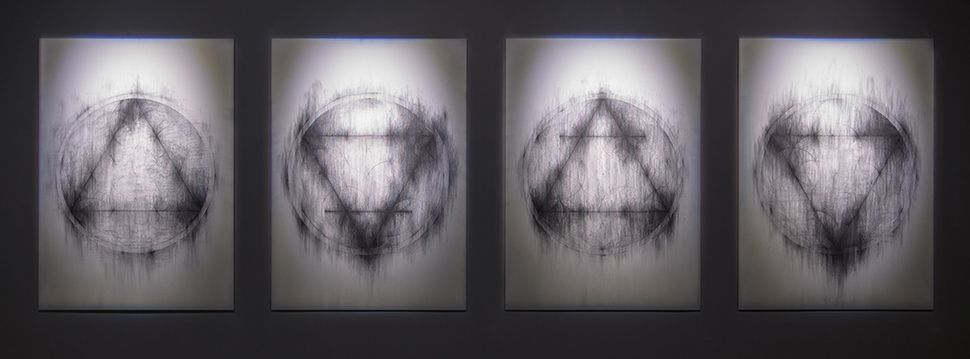
《火、土、風、水》 / Fire, Earth, Air, Water|Charcoal, pencil|109 x 79 cm each|2017
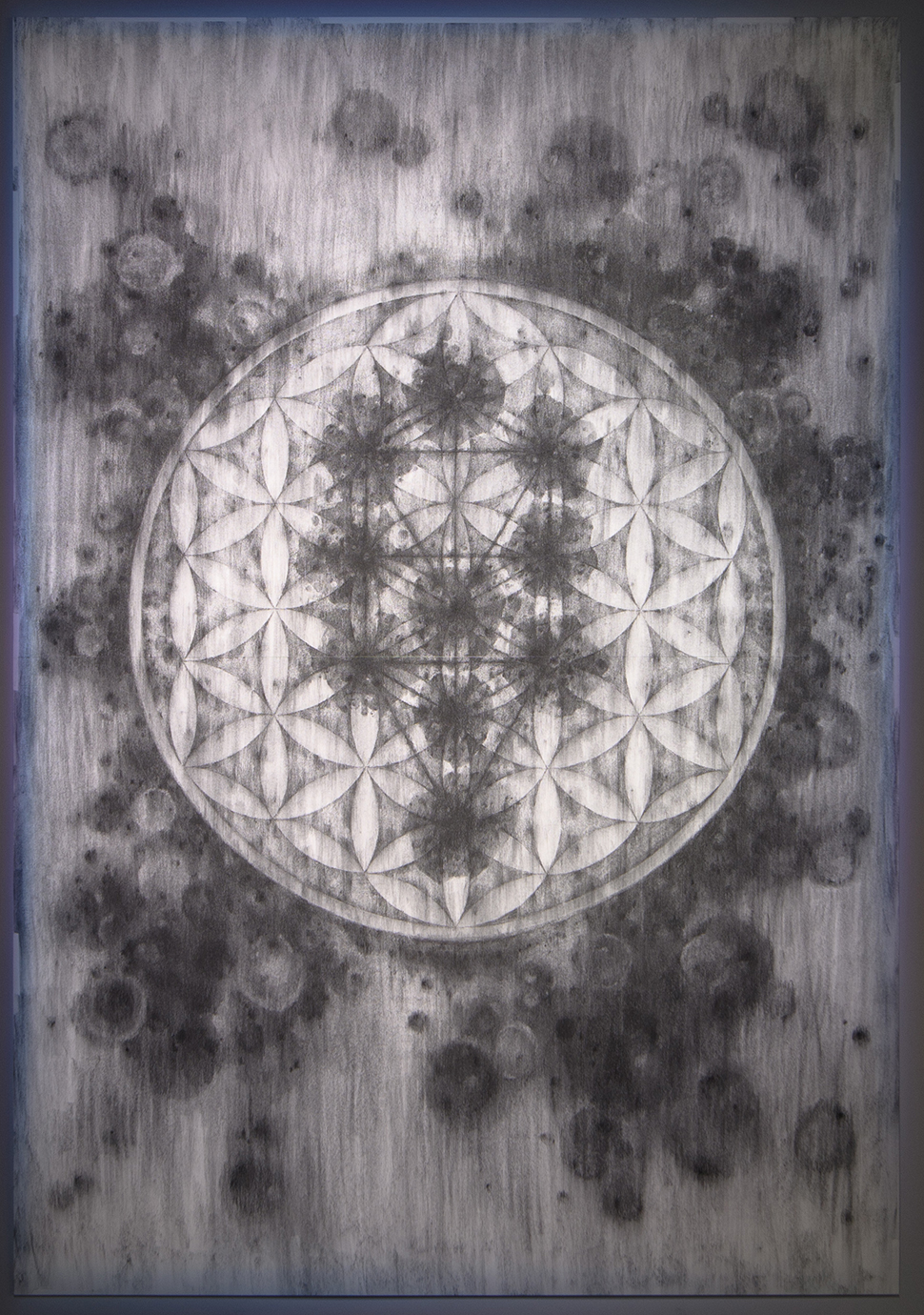
《生命之花》/Flower of Life|Charcoal, pencil|157.5 x 109 cm|2017
2021 Notes on Psychedelics III: 2-19-20 //// 2018-2020/ Sonic Driving //// 2018/ Reverberation of the Pleiades //// 2018/ Extrastellar Evaluations III : Entropy : 25800 //// 2016/ Extrastellar Evaluations //// 2015/ Notes on Psychedelics //// 2015/ Action at a Distance //// 2014/ Liquidation Maps //// 2013-2014/ As Above, So Below //// 2012/ One Universe, One God, One Nation //// 2011/ The Turner Archives

 超星鑑定 Extrastellar Evaluations
超星鑑定 Extrastellar Evaluations
2016
Multimedia installation: 3 projections, 1 monitor, 36 metal plates (each 48 x 48 cm), vinyl cut pattern, 28 framed photos, 1 handwritten letter, 24 clear quartz crystals
多媒體裝置/三個投影、一件電視播放、三十六 只金屬片(48公分x48公分)、卡典西德、二十 八張檔案照片、一封手寫信件、二十四顆水晶
Extrastellar Evaluations is a project that displays evidence of the connected history of the Lemurians, an alien said to pre-date human civilization, and art from the 1960s. A video combines found footage, animation and text with imagery shot at the Lemurian sites in California. An accompanying wall diagram with images of renowned American artworks and monuments acts as a network of association linking art and alien communication.
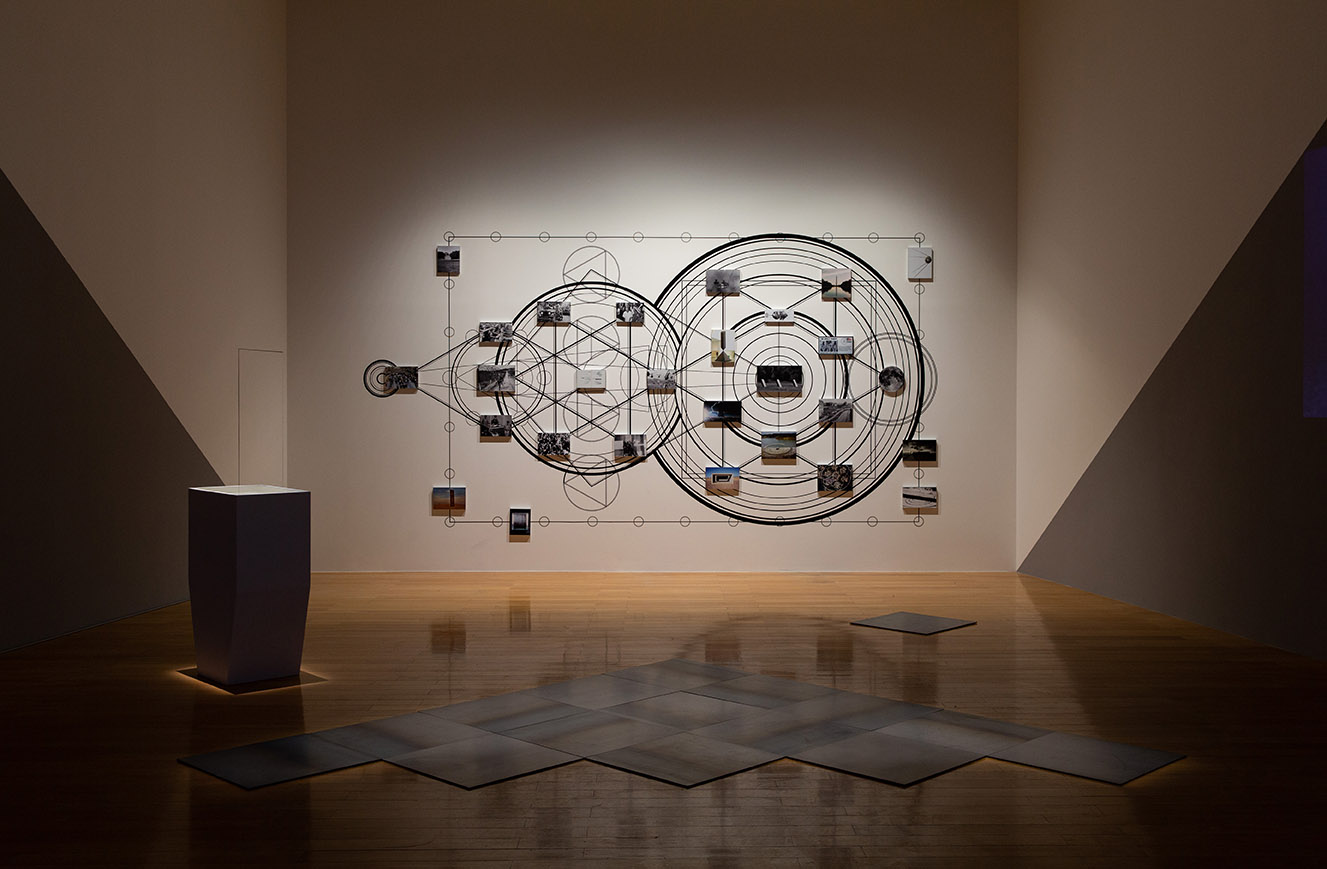
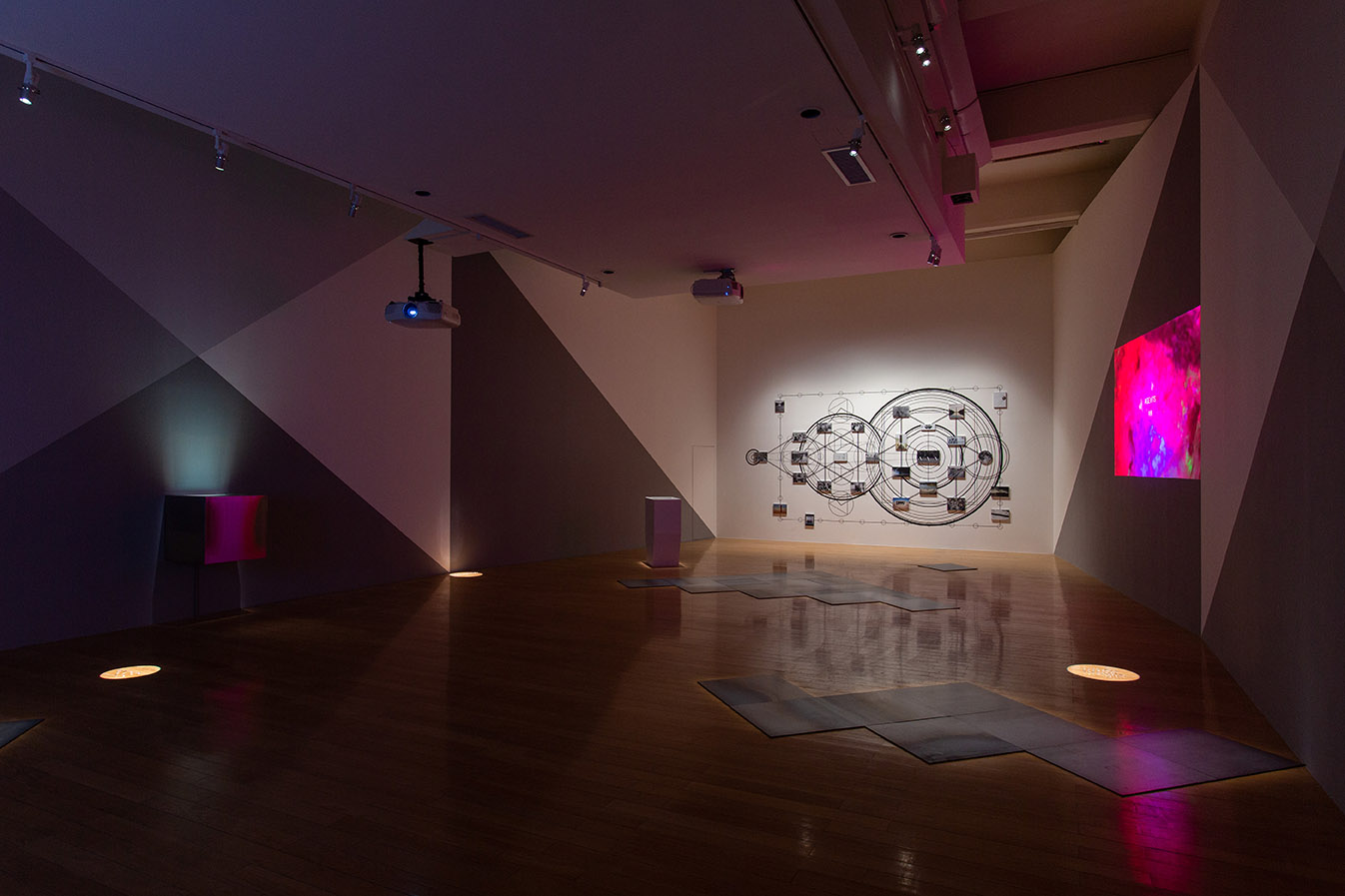
Installation view at Taipei Fine Arts Museum, 2021
Marie Martraire
Despite common belief, some alien inhabitants of the lost continent of Lemuria survived its sinking on Earth thousands of years ago.1 Limited information prevents researchers from fully comprehending the outer space population, their demographics and customs, or even the reason for their subsistence on Earth, resulting in inconsistent versions of their subsequent histories. Yet multiple accounts have established with quasi-certainty that some Lemurians remain on Earth today near its core, deep beneath the 14,179-foot Mount Shasta, CA, appearing infrequently to human witnesses. Following her investigation into the mysterious residents of Mount Shasta, Kadist A.I.R. Yin-Ju Chen conducted field research and interviews with local inhabitants of the volcanic territory. Her exhibition and multimedia installation, at Kadist, Extrastellar Evaluations, uncover unique materials that reveal unforeseen information about the Lemurians’ earthly presence.
Consisting of archival photographic and video materials, as well as objects created by Lemurians, the works featured in the exhibition function as evidence confirming that Lemurians were evolving among human communities in the mid-20th century under the identities of artists, practicing in the United States. Including many familiar names to the human art world like Carl Andre, Mel Bochner, and James Turrell among others, these personas used forms like cubes, monoliths, obelisks, crop circles, etc. as communication tools to report back on human actions to their mother planet. Channeled through a psychic medium named Lucia, a video introduces us to these translated messages from Adama, High Priest and spiritual leader of the Lemurians. A graphic representation in the space highlights the multitude of possible relations between the delivered information (human actions), their mediums (so-called minimal and conceptual works), and the space in which they evolve (universe).
Extrastellar Evaluations focuses specifically on the 1960s as a key historical era for both Lemurians and humans. For humans, the 1960s denoted a complex interrelation of cultural and political events worldwide amid the 1962 Cuban Missile Crisis, the beginning of the Cold War (1962–1979), the enduring Vietnam War (1955-1975), Africa’s independence movements, Cultural Revolution in China (1966–1976), African-American civil rights movements and 1968 protests in Europe, the 1968 assassination of Martin Luther King, Jr., to name a few. For Lemurians, this era was marked by a series of severe weather events that disturbed their transmission routes, such as record-breaking flooding and snowstorms (1955/56, 1959, 1964/65, etc.). 2 Pushed far beyond the immediate vicinity of Mount Shasta as a consequence, the Lemurians sought new forms of and locations for communication with their motherland. They initiated prolific creations of geometric-shaped transmission devices on a national scale, made visible by human interpretation and appropriation as conceptual and minimalist artworks.
Revisiting dreadful human actions of the 1960s through the lens of outer space intelligence, Extrastellar Evaluations questions our understanding of our past while encouraging different interpretations of our existence on earth. In this context, the multimedia installation opens consciousness toward the risks of human activities, echoing today’s anxieties toward issues of global warming, continuous conflicts and exploitation of resources. In addition, mirroring its past, present and future, Yin-Ju Chen’s work addresses early signs of our becoming lost in this world. In doing so, the artist echoes theorist Franco "Bifo" Berardi’s observation of humans’ loss of faith in the reality of life, suggesting a larger, long-term phenomenon rather than a recent trend linked to the development of media and information technology.3 In light of Lemurians’ ambiguous presence on earth, the installation also implies the inevitability of the cycles of history, sealed by an external force–as evidenced by Chen’s 2012 three-channel video installation One Universe, One God, One Nation examining the dictatorship of Chinese leader Chiang Kai-Shek. Considered alongside this latter body of work, Extrastellar Evaluations develops the scope of Chen’s long-term consideration of notions of "power" and collective (un)consciousness.
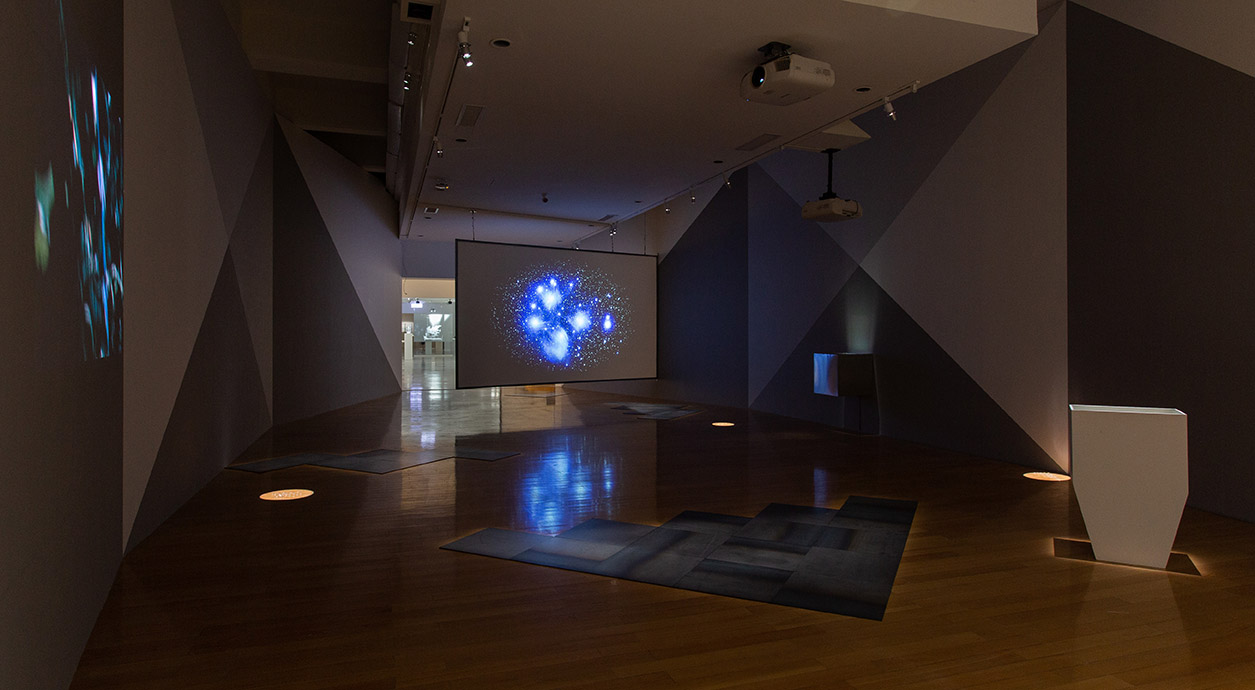
關於《超星鑑定》
Marie Martraire
儘管普遍地認為,在好幾千年前,一些外星生物在雷姆利亞大陸(Lemuria)沉沒時倖存下來1,但限有的資訊使研究人員無法充分掌握外星人口、統計數字與風俗習慣,甚至無法理解它們在地球生存的理由,導致後續歷史有眾多版本。然而,許多確信無礙的紀錄證實,一些雷姆利亞人今日仍留在距地心很近的地方,位在加州雪士達山底下4322公尺下方,並罕見於人類社會。在陳瀅如對雪士達山的神祕居民做了調查後,藝術家在這火山地區進行田野調查,並與當地居民實地訪談。她的裝置作品《超星鑑定》(2016)揭露了雷姆利亞人存在於地球,使人料想不到的獨特資料。
結合檔案照片和錄像材料,以及雷姆利亞人創造的物件,這件計劃的功能宛如一個證據,證實在二十世紀中期,雷姆利亞人以美國藝術家之姿作為掩飾,在人類社群展進。包含許多人類藝術圈耳熟能詳的名字,如卡爾.安德烈(Carl Andre)、梅爾.博赫納(Mel Bochner)和詹姆斯.特瑞爾(James Turrell)等人,這些人利用立方體、巨石、方尖石塔,麥田圈等形式來作為溝通工具,回報原生星球有關人類的活動。經由靈媒露西亞的通靈協助,計劃中的影片翻譯了雷姆利亞大祭司與精神領袖阿達瑪(Adama)的訊息。而一副圖解式的再現方法,標記出傳遞的訊息(人類活動)、媒介(所謂的極限與觀念藝術),以及他們演繹的空間(宇宙)等許許多多彼此間潛藏的關係。
《超星鑑定》著眼於六〇年代,這個雷姆利亞人與人類的關鍵歷史時刻。六〇年代象徵了國際間複雜的文化、政治的相互關係,例如1962年的古巴飛彈危機、冷戰的開始(1962-1979)、冗長煎熬的越戰(1955-1975)、 非洲獨立運動與1968年歐洲抗 議事件、中國文化大革命(1966-1976)、非裔美國人人權運動(1954-1968)、1968年馬丁路德金被暗殺等等。對雷姆利亞人來說,這個時代加計了一系列嚴重阻擾通訊的天災,如破紀錄的洪水以及暴風雪(1955/56, 1959, 1964/65等紀錄)2。由於逼鄰雪士達山,雷姆利亞人尋求新的方式和地點來與母星通訊。 祂們發起、並發明了豐富遍及全國的幾何形狀的傳動裝置,以人類的詮釋並被人類拿來挪用為觀念與極限藝術的方式顯現出來。
通過外星智慧的角度,重新審視六〇年代可怕的人類活動,《超 星鑑定》質疑我們對過去的瞭解,也鼓勵存在地球上不同角度的歷史詮釋。以此來龍去脈,複合媒材裝置使人們對人類活動的危機產生意識,呼應了今日對於全球暖化、持續衝突、濫用資源等問題的憂慮。此外,鏡像過去,現在、未來,陳瀅如的作品呈現我們在這個世界逐漸迷失的徵兆。在這情況下,藝術家呼應了理論家法蘭克貝拉迪對人類面對現實生活喪失信心的觀察,提出一個更宏觀更長久的現象,而不是發展媒體與資訊科技的近來趨勢3。鑑於雷姆利亞人若有似無地在地球上存在,這件裝置計畫也意味著被外力封密起來的歷史重演之必然性──如藝術家在 2012年的《共登世界大同之境》審視中國獨裁者蔣介石這件作品的佐證。同時,這件後續作品《超星鑑定》擴展了陳瀅如長期關心的權力與集體(無)意識議題之視野。
1. College of the Siskiyous, "The Origin of the Lemurian Legend" www.siskiyous.edu/shasta/fol/lem/index.htm2. College of the Siskiyous, "Historical Storms of Mount Shasta." www.siskiyous.edu/shasta/env/storm/
3. Franco "Bifo" Berardi, Introduction to The Wretched of the Screen, by Hito Steyerl (Steinberg Press, 2012), 9-11.
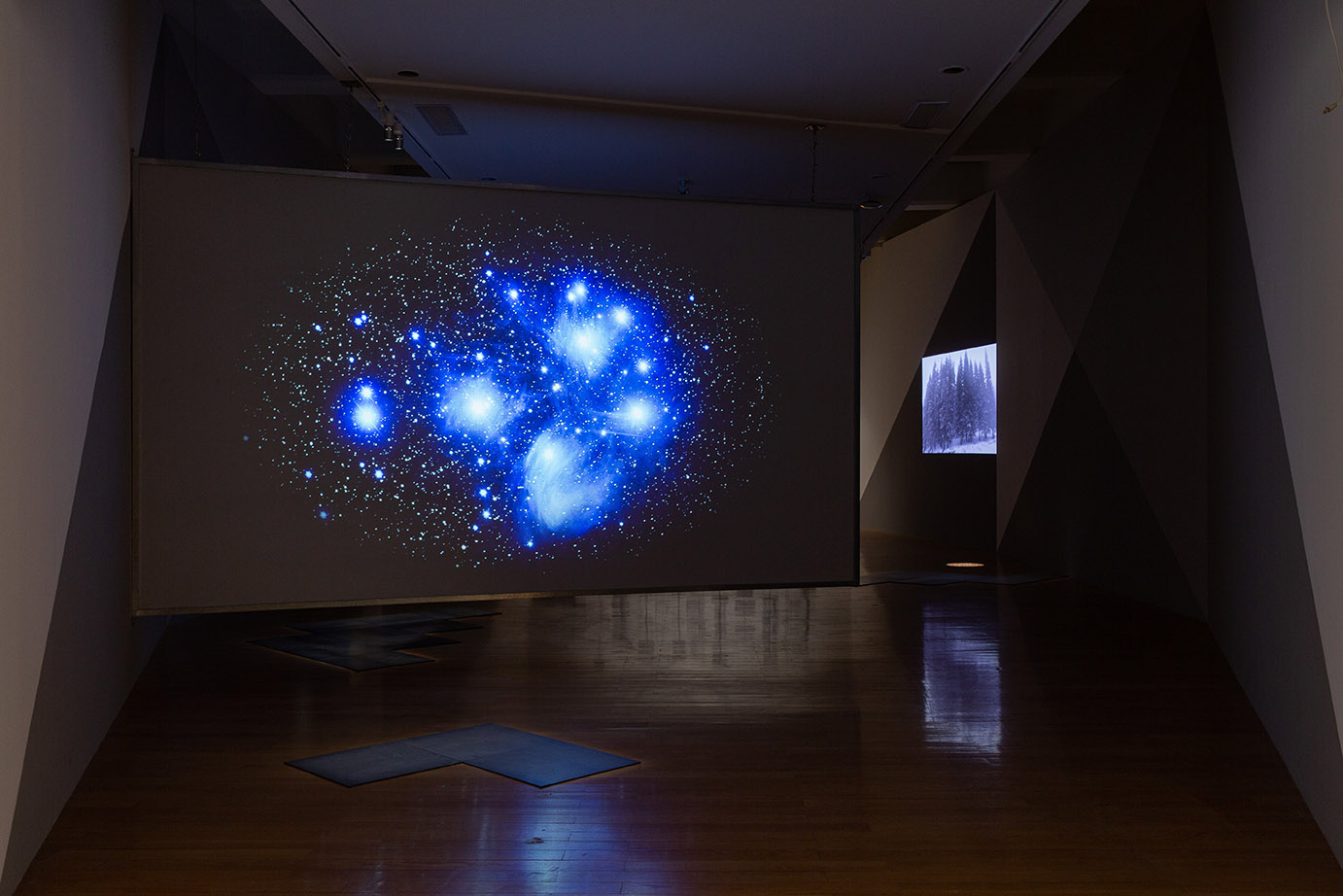 |
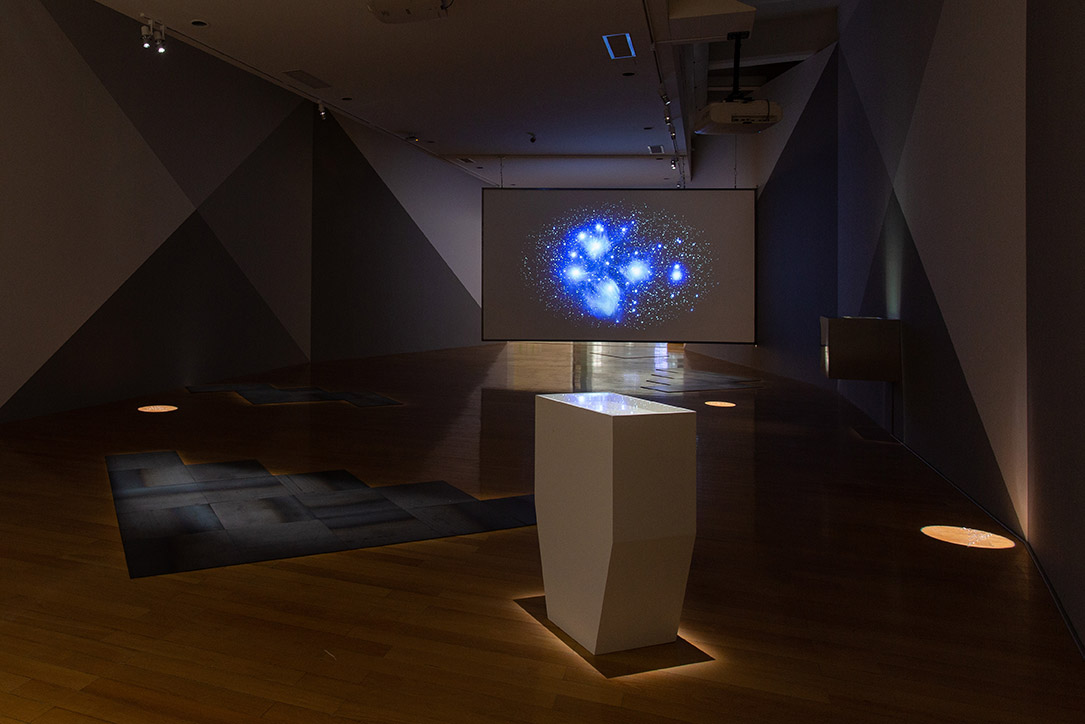 |
 |
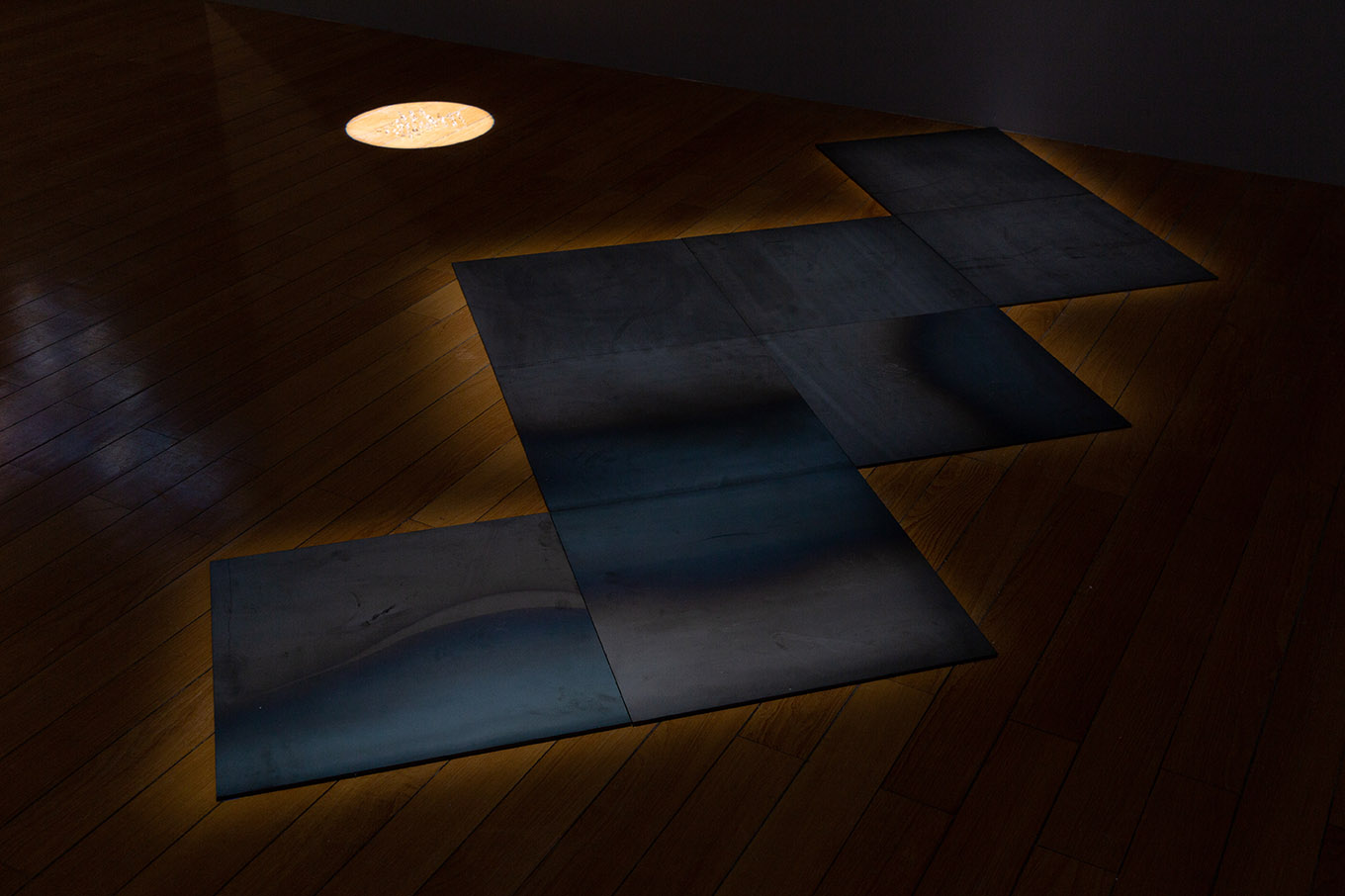 |
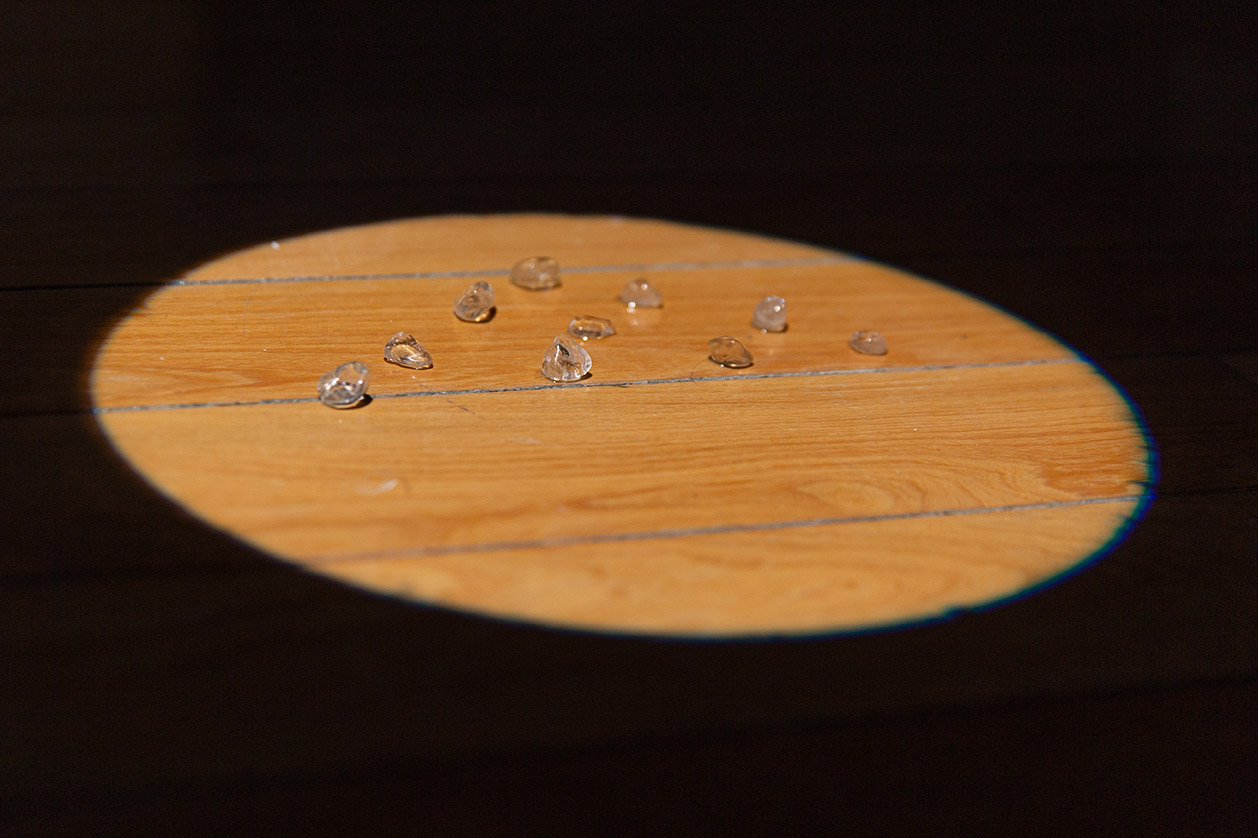 |
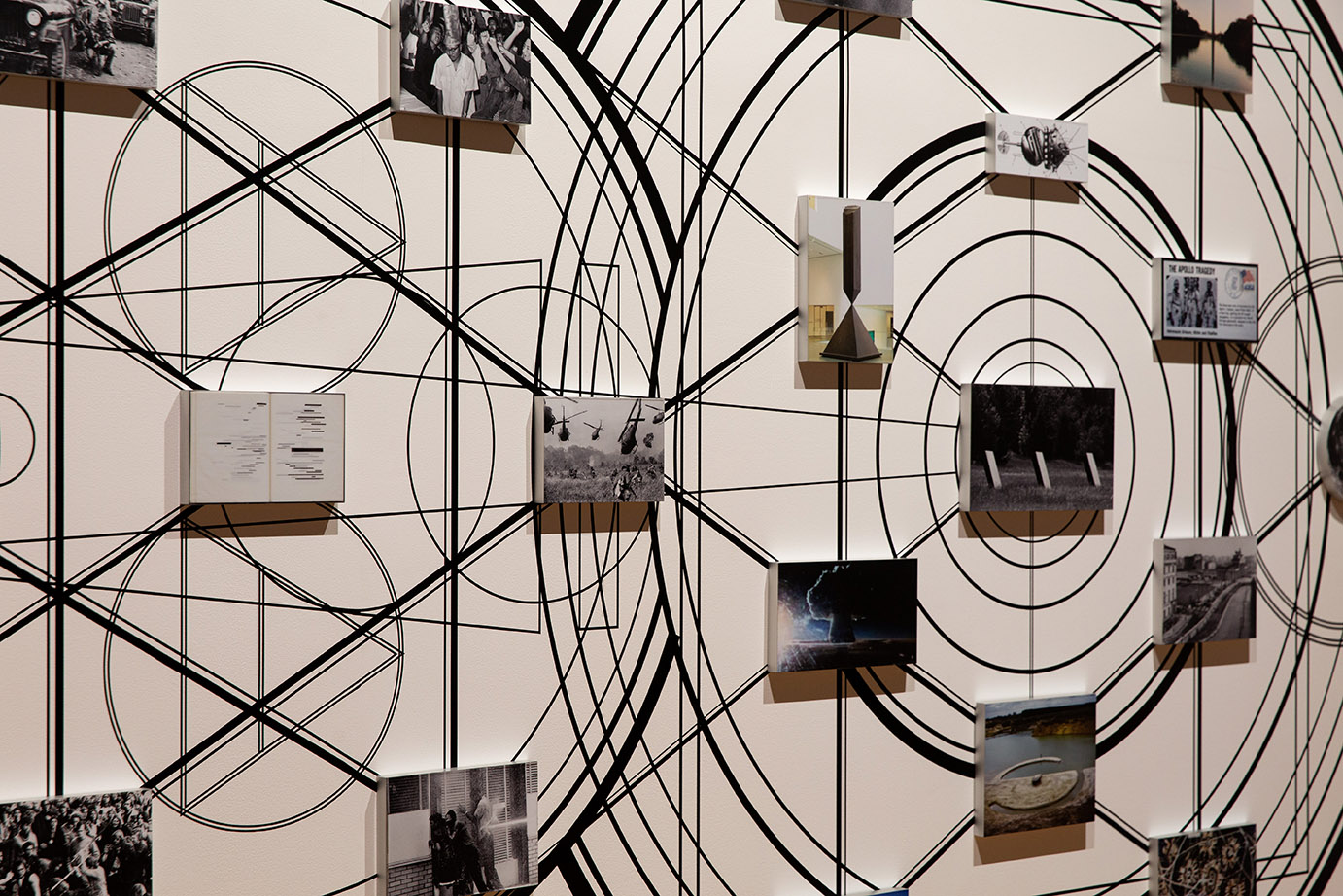 |
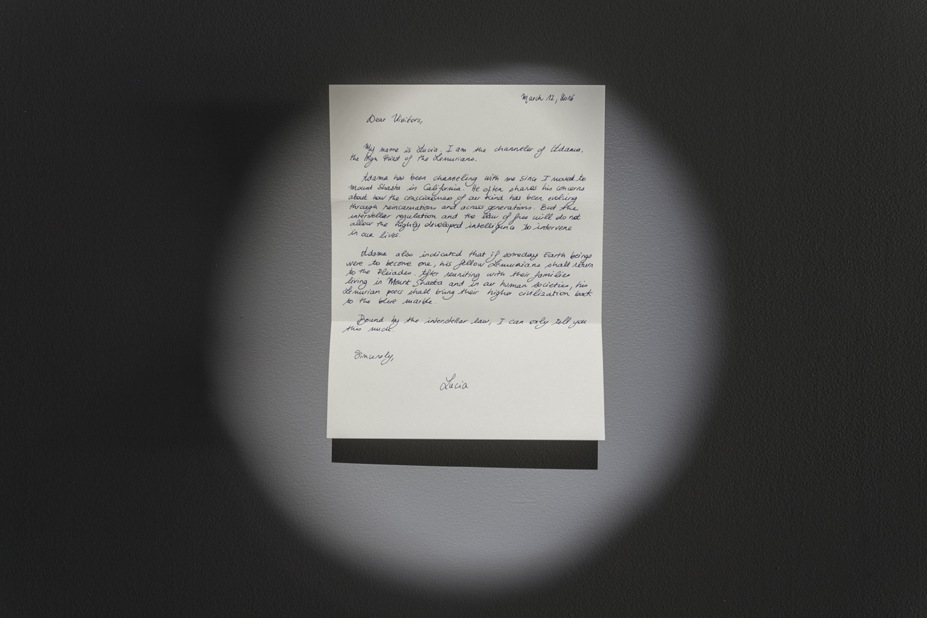
Contents of the letter:
Dear viewers,
My name is Lucia, I am the channeler of Adama, the high priest of the Lemurians. Adama has been channeling with me since I moved to Mt Shasta in California. He often shares his concerns about how the consciousness of our kind has been evolving through reincarnations and across generations. But the interstellar regulation and the law of free will do not allow the highly developed intelligence to intervene in our lives. Adama also indicated that if someday Earth beings were to become one, his fellow Lemurians shall return to the Pleiades, after reuniting with their families living in Mount Shasta and in our human societies, his Lemurian peers shall bring their higher civilization back to the blue marble. Bound by the interstellar law, I can only tell you this much.
yours, Lucia
親愛的觀眾,
我是露西亞,阿達瑪的靈媒。自從我搬到雪士達山後,阿達瑪和我經常通靈。
祂一直關注經過如此多的世代轉世,我們人類意識的進化似乎不完善。然而,由於星際法則與自由意志的定律,高度進化的智慧生物不允許干涉我們的生活。
阿達瑪指示,如果有一天地球所有的物種成為完整的一體,祂的雷姆利亞同胞會從昴宿星重返地球,不僅與祂們在雪士達山與人類社會的家人團聚,也會把高度文明帶回藍色星球。
基於星際法則,我承諾過我只能說這麼多。
誠摯的露西亞
2021 Notes on Psychedelics III: 2-19-20 //// 2018-2020/ Sonic Driving //// 2018/ Reverberation of the Pleiades //// 2018/ Extrastellar Evaluations III : Entropy : 25800 //// 2016/ Extrastellar Evaluations //// 2015/ Notes on Psychedelics //// 2015/ Action at a Distance //// 2014/ Liquidation Maps //// 2013-2014/ As Above, So Below //// 2012/ One Universe, One God, One Nation //// 2011/ The Turner Archives

 《致幻記》Notes on Psychedelics
《致幻記》Notes on Psychedelics
2015Multimedia installation: 3 archival and new videos, numerous archival images, books, texts, and objects
多媒體裝置:三支錄像訪談、演講,現成物,文字
 |
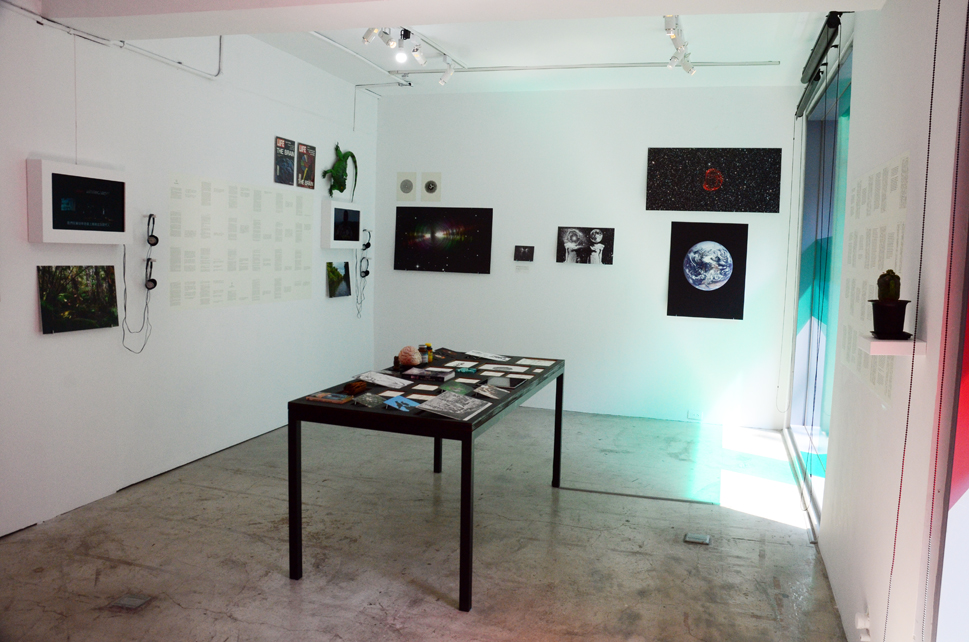 |
Notes on Psychedelics (2015) is a survey of drugs, consciousness, and the soul. It investigates the motivations behind the consumption of psychedelic drugs and focuses on the substance called DMT (N,N-Dimethyltryptamine), which is biologically and naturally released by the pineal gland or the third eye within the brain.
Encompassing philosophy, religion, medical science, art, and cults, my practice daringly and rigorously assumes that the universe has its own consciousness, and as human beings we all seek our own paths that seem ostensibly different, but eventually return to the universe.
《致幻記》(2015)是對藥物、意識、靈魂的一項研究計劃,調查使用致幻劑背後的確實動機,並著眼於稱為DMT(N,N-Dimethyltryptamine)的物質。就生物學上來說,DMT 會經由腦內的松果體,即俗稱的第三眼所自然釋放。
綜觀哲學、宗教、醫學、藝術、神秘學,《致幻記》大膽假設宇宙是有意識的,同時我們都用不同的角度去尋找回歸宇宙、與宇宙合一的路途。
// YJC, Taipei, 2015
Although the soul is joined with the entire body, there is one part of the body [the pineal] in which it exercises its function more than elsewhere… [The pineal] is so suspended between the passages containing the animal spirits [guiding reason and carrying sensation and movement] that it can be moved by them…; and it carries this motion on to the soul … Then conversely, the body machine is so constituted that whenever the gland is moved in one way or another by the soul, or for that matter by any other cause, it pushes the animal spirits which surround it to the pores of the brain. (Descartes, René. The Inter-Relation of Soul and Body, in The Way of Philosophy, 1954, 357)
雖然靈魂結合了整個身體,但在身體的某部份(松果體)在功能上卻遠勝於其他器官(松果體)在可被啟動的動物靈性中(理性引導並兼顧感知與動作)與運載靈魂的航道之間游移⋯相反地,身體機器被設計成每當松果體被靈魂以不同方式引動,或被其他任何因素牽引,環繞在腦部毛孔周圍的動物靈性便被驅動。(笛卡兒 Descartes, "The Inter-Relation of Soul and Body," in The Way of Philosophy, 1954, 357)
The eye, at the summit of the skull, opening on the incandescent sun in order to contemplate it in a sinister solitude, is not a product of the understanding, but is instead an immediate existence; it opens and blinds itself like a conflagration, or like a fever that eats the being, or more exactly, the head. And thus it plays the role of a fire in a house; the head, instead of locking up life as money is locked in a safe, spends it without counting, for, at the end of this erotic metamorphosis, the head has received the electric power of points. This great burning head is the image and the disagreeable light of the notion of expenditure, beyond the still empty notion as it is elaborated on the basis of methodical analysis. From the first, myth is identified not only with life but with the loss of life with degradation and death. Starting from the being who bore it, it is not at all an external product, but the form that this being takes in his lubricious avatars , in the ecstatic gift he makes of himself as obscene and nude victim-and a victim not before an obscure and immaterial force, but before great howls of prostitutes' laughter. Existence no longer resembles a neatly defined itinerary from one practical sign to another, but a sickly incandescence, a durable orgasm." (Bataille, Georges. The Pineal Eye, in Visions of Excess: Selected Writings, 1927-1939, 82)
眼睛,位在頭骨的峰會,為了注視太陽毒辣的孤寂而在白熾中睜開,它不是用來認知的產物,而是一種立即的存有;它在睜閉之間猶如大火一般,或如同發燒一樣吞噬著生命,或是更精確地說,吞噬頭部。因此,它扮演者房子裏的大火;頭部,不像金錢鎖在保險箱裡一樣將生命鎖上並且毫無計算的花費,它是為了在最終情色變態時能接收到關鍵的電流。熊熊燃燒的頭是消耗概念的意象與令人不快活的光體。當它被基礎系統性分析闡述時,便超越了靜止空洞的觀念。
最初,神話不僅被認同為生活,也代表失落的生命:退化與死去。從一個生命開始承載它,這不全然是外部化,而是以具體化後的淫蕩來作為形式,在迷幻作用下,讓自己作為猥褻和裸體受害者:不是在暗昧模糊與物質驅使之前,而是在妓女笑虐狂嚎之前的受害者。
存有不再相似於實用符號的整齊行程序列,而是病態的熾熱和持久的性高潮。(巴代伊 Bataille, Georges, "The Pineal Eye" Visions of Excess-Selecte writings,1927-1939, 82》
My brain is only a receiver, in the Universe there is a core from which we obtain knowledge, strength and inspiration. I have not penetrated into the secrets of this core, but I know that it exists. (Tesla, Nikola)
我的大腦只是個接收器。宇宙存有一個核心,我們所須的知識、力量、靈感都在那裡。我未曾置身這個核心祕境,但是我知道它確實存在。(尼古拉 · 特斯拉)
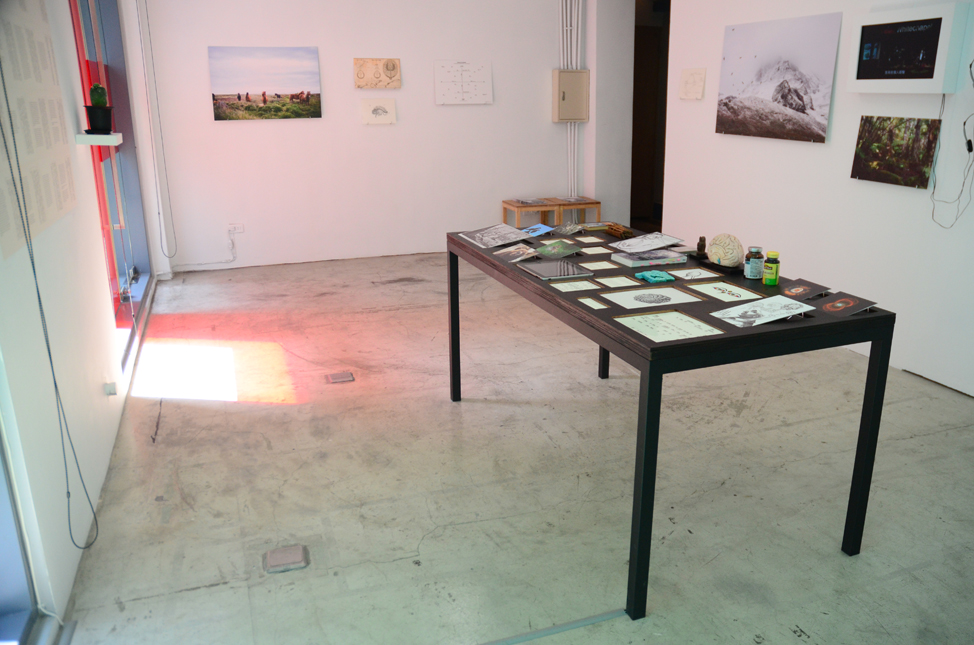 |
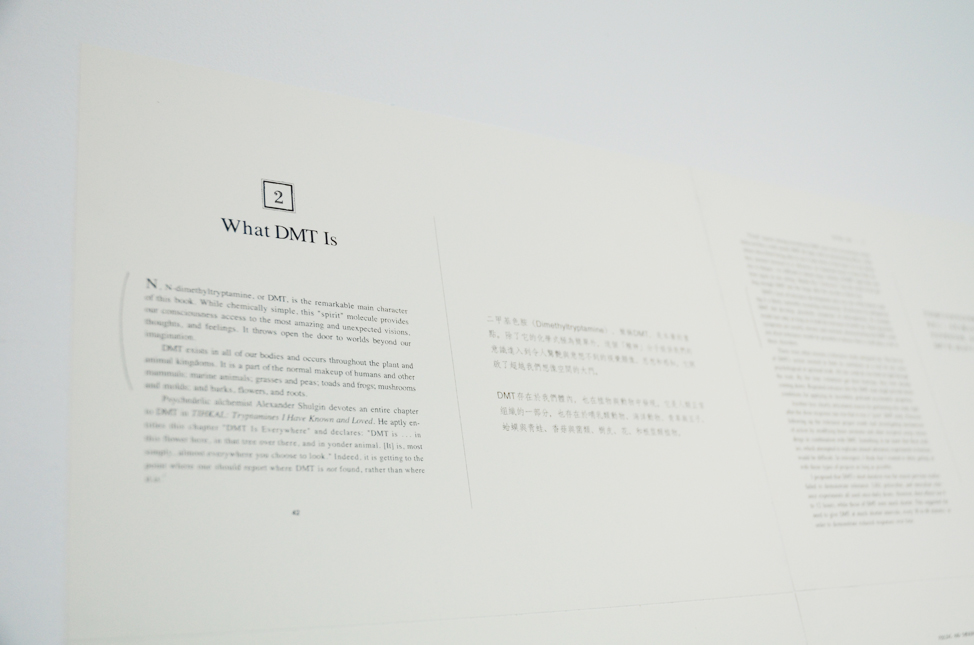 |
2021 Notes on Psychedelics III: 2-19-20 //// 2018-2020/ Sonic Driving //// 2018/ Reverberation of the Pleiades //// 2018/ Extrastellar Evaluations III : Entropy : 25800 //// 2016/ Extrastellar Evaluations //// 2015/ Notes on Psychedelics //// 2015/ Action at a Distance //// 2014/ Liquidation Maps //// 2013-2014/ As Above, So Below //// 2012/ One Universe, One God, One Nation //// 2011/ The Turner Archives

 《超距作用》Action at a Distance
《超距作用》Action at a Distance
20153 channel video installation | 3 passages of texts | 9'16"
三頻道錄像同步裝置|9'16"|三段限地製作卡典西德文字
影片預覽 | video preview
Action at a Distance is a three-channel synchronized video installation that draws parallels between traumas to the body and to society. Combining a range of archival imagery of surgery and laboratory experiments, depictions of astronomy, astrology and quantum mechanics, and footage of governmental crack-downs on public protests in Asia, it reflects on the interconnectedness of actions from the subatomic, through the macrocosmic, to the universal.
《超距作用》呈現一系列創作計劃的第三章: 最初以《天一象、地一物 》(2013-2014)開始──藉由神秘學的角度探討身體與現代醫學;到《屠學錶》(2014)──由天象、占星的方式理解亞洲近代屠殺事件和歷史;到第三章節《超距作用》(2015)將身體與國家並置,以量子力學中的量子糾纏原理爲敘事界面,藉由現代物理科學的哲學觀,來理解人類與宇宙法則之間的微妙關係與相互作用。
大宇宙、小宇宙之間的密切關聯,以及上下一致法則,一直是我近年來創作、研究中不可或缺的觀看介質;換句話說,大小宇宙的觀念,是我用以探討身體、政體、集體意識的研究方法,也是呈現這個長達兩年半創作計劃的關鍵。
愛因斯坦被超距作用或量子糾纏現象所困擾,稱之爲「鬼魅似的遠距作用」。這件創作計劃凝聚在人類與宇宙之間不停地交織、互相產生作用。從古至今,我們不斷地試圖理解世界與生命;無論是偽科學還是科學,不同的研究方法或是思考模式,了解生命的方式終究同歸而殊途,一致而百慮。
 |
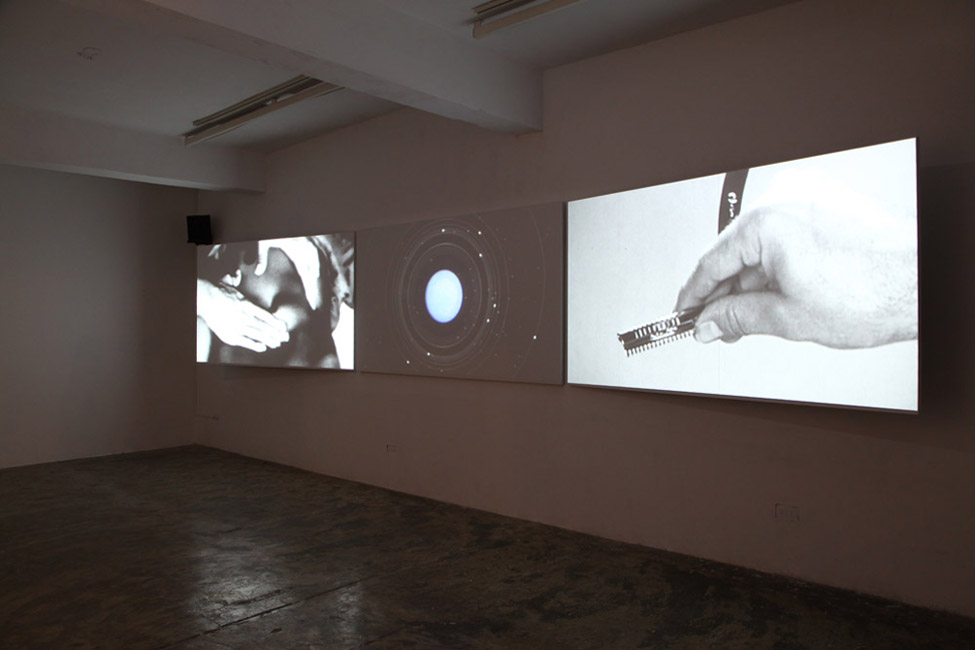 |
Solo Exhibition | Installation view | IT PARK | Taipei
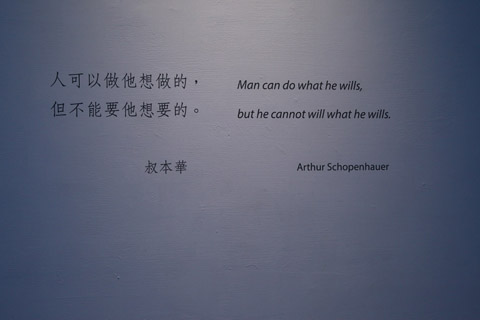 |
Man can do what he wills, but he cannot will what he wills.
Arthur Schopenhauer |
 |
 |
Book of Rites - Great Learning
The ancients who wished to illustrate illustrious virtue throughout the kingdom, first ordered well their own states. Wishing to order well their states, they first regulated their families. Wishing to regulate their families, they first cultivated their persons. Wishing to cultivate their persons, they first rectified their hearts. Wishing to rectify their hearts, they first sought to be sincere in their thoughts. Wishing to be sincere in their thoughts, they first extended to the utmost their knowledge. Such extension of knowledge lay in the investigation of things. Things being investigated, knowledge became complete.
Their knowledge being complete, their thoughts were sincere. Their thoughts being sincere, their hearts were then rectified. Their hearts being rectified, their persons were cultivated. Their persons being cultivated, their families were regulated. Their families being regulated, their states were rightly governed. Their states being rightly governed, the whole kingdom was made tranquil and happy. From the Son of Heaven down to the mass of the people, all must consider the cultivation of the person the root of everything besides. It cannot be, when the root is neglected, that what should spring from it will be well ordered. It never has been the case that what was of great importance has been slightly cared for, and, at the same time, that what was of slight importance has been greatly cared for.
The text of the lower right:
Quantum Entanglement
In quantum physics, entangled particles remain connected so that actions performed on one affect the other, even when separated by great distances.
The phenomenon so riled Albert Einstein he called it "spooky action at a distance."
2021 Notes on Psychedelics III: 2-19-20 //// 2018-2020/ Sonic Driving //// 2018/ Reverberation of the Pleiades //// 2018/ Extrastellar Evaluations III : Entropy : 25800 //// 2016/ Extrastellar Evaluations //// 2015/ Notes on Psychedelics //// 2015/ Action at a Distance //// 2014/ Liquidation Maps //// 2013-2014/ As Above, So Below //// 2012/ One Universe, One God, One Nation //// 2011/ The Turner Archives

 《屠學錶》Liquidation Maps
《屠學錶》Liquidation Maps
2014
5 charcoal and pencil on papers (125 x 125 cm), HD videos (color, loop), printed documents
五張素描,各125 x 125 公分、兩件投影、文件
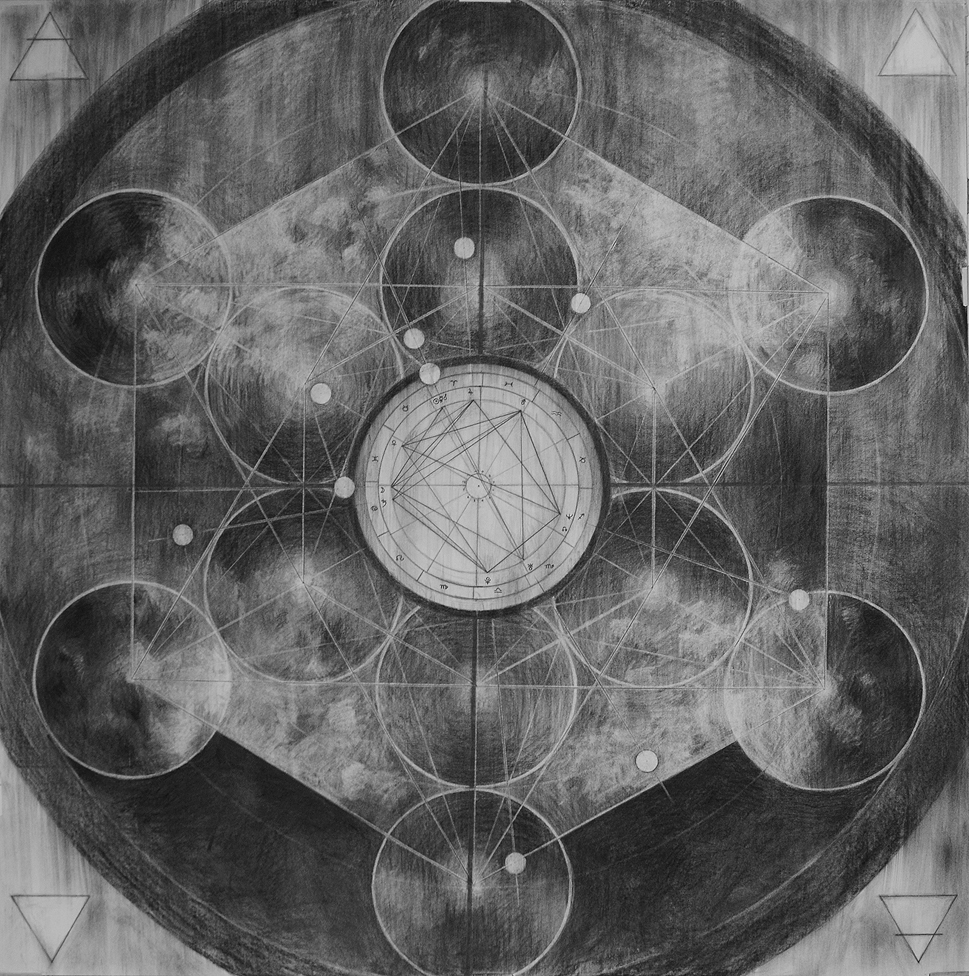
Khmer Rouge 1975-1978 | Charcoal, pencil |125 cm x 126 cm | (One of five)
Liquidation Maps is a series of works that reexamines and investigates political genocides and massacres in recent Asian history from an occult angle, fusing astrology and astronomy. Yin-Ju Chen has chosen five historical events: Leiyu Kinmen Massacre in 1987 (Taiwan), Sook Ching Massacres in 1942 (Singapore), Khmer Rouge genocide in 1975 (Cambodia), massacres in East Timor in 1999 and Gwangju Uprising in 1980 (South Korea). Chen has created star charts based on astrological permutations at the time when these historical incidents started, and extrapolated upon the circular nature of the star charts into mandalas for each incident. The star charts and mandalas are symbols of reincarnation and non-linear time. The circular shape bring to mind the circular design of wrist watches, and the Chinese title plays on the Mandarin homophones of "chart" and "wristwatch".
By re-examining historical incidents through the lens of the occult, Chen is not only attempting to rethink the subjective awareness of history writing in textbooks from the past, she is also questioning whether such actions by humanity are inevitable under the predetermined and inexorable laws of the universe, whether these laws constitute a form of cosmic force majeure. Corresponding to the belief that purification and perfection are achievable through violent means, in the artist's video work, the planet Mars represents the god of war and Pluto represents the utter persecution and destruction that precedes the reconstitution of order. This underlying concept is similar to Jung's belief that one's natal chart could represent a prototype of collective human consciousness. In critiquing Chen's work, critic Rikey Cheng pointed out that "natal charts are a form of intellectual temptation for their audience, as their symbolic meaning only surrenders to the manipulation of the hand that draws the chart, provided that information is masked and phases are purposely made vague… And these sketches adhere more closely to the labors of ancient astrologers rendering natal charts by hand in the absence of computer technology. Rather than bringing audiences an instant chart readout with internet technology, they lead viewers on a voyage of discovery towards the soul."1
1 From "A User Guide to Internal Maps", Rikey Cheng's commentary at Yin-Ju Chen's 2014 Dead Souls at the Test Drive exhibition.
《屠學錶》是一系列透過神秘學的角度,結合占星與天文科學的方法,來重新檢視並研究近代亞洲政治清算與屠殺事件。陳瀅如選擇五起歷史事件:1987年小金門屠殺難民、1942年新加坡肅清大屠殺、1975年紅色高棉屠殺、1999年東帝汶屠殺以及1980年光州事件,利用這些歷史事件發生當下的星空排列組合繪製出占星星盤,並依循圓形星盤的特質畫出屬於每一歷史事件的曼陀羅圖騰。星盤、曼陀羅圖騰皆象徵輪迴與非線性的時間,《屠學錶》便以此為名,如同手錶上的圓圈式計時。 陳瀅如以神秘學的角度切入重新回看歷史事件,除了對過往教科書上對於歷史書寫的主觀意識提出反思外,也試圖提問人類對其行為之可與不可為,在宇宙既定運行上下一致法則下,是否因而形成了不可抗力。這種以暴力手段達到淨化、完美的信念與目的,對應著錄像中火星與冥王星所代表的戰神與秩序重整前的絕對迫害與毀滅,如同榮格所認為命盤如何展現人類心靈的集體原型。藝評人鄭文琦針對陳瀅如的作品指出:「解讀命盤之於觀眾是一種智性誘惑,唯有遮蔽信息和模糊相位才能有效地使象徵符號臣服於手繪操作痕跡下……而這些素描更接近古代占星師在沒有計算機輔助時親手繪製命盤的勞力過程,帶領觀眾親近的不是仰賴網絡科技的實時命盤解讀,而是一條通往心靈的發現之旅...」1
1 引用自「內在地圖的使用指南」,鄭文琦評陳瀅如《試駕靈魂》2014展覽一文,藝外雜誌63期,2014年12月號。
文字來源:2014 上海雙年展-社會工廠
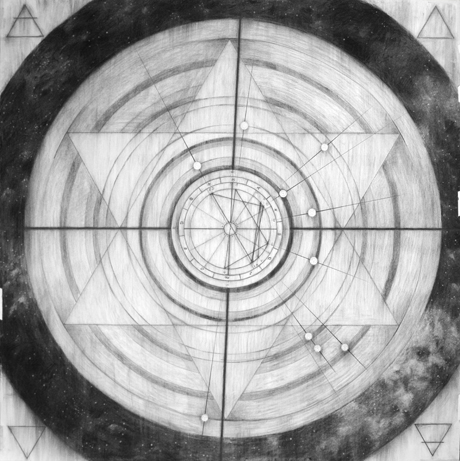 Leiyu Massacre, Taiwan, 1987 |
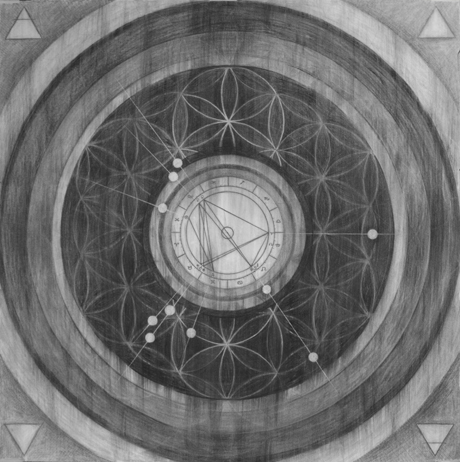 Sook Ching Massacre, Singapore, 1942 |
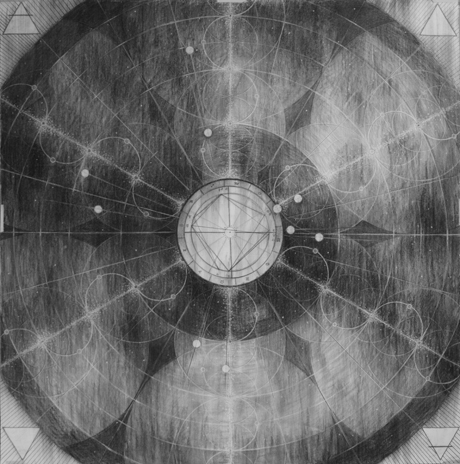 East Timorese Crisis, East Timor, 1999 |
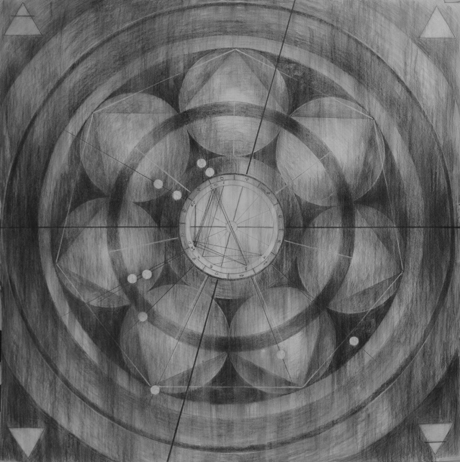 Gwangju Uprising, South Korea, 1980 |
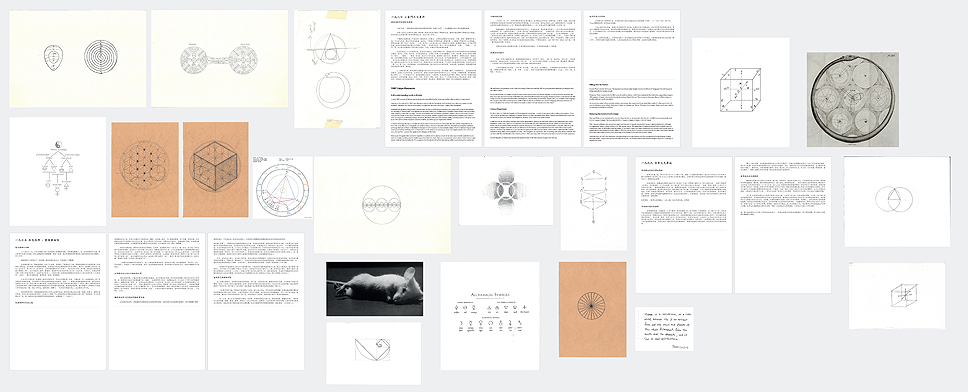
drawing & text collections 1 | pencil, ink, photocopies | size varied | 2014
事件占星解讀與其它相關文件
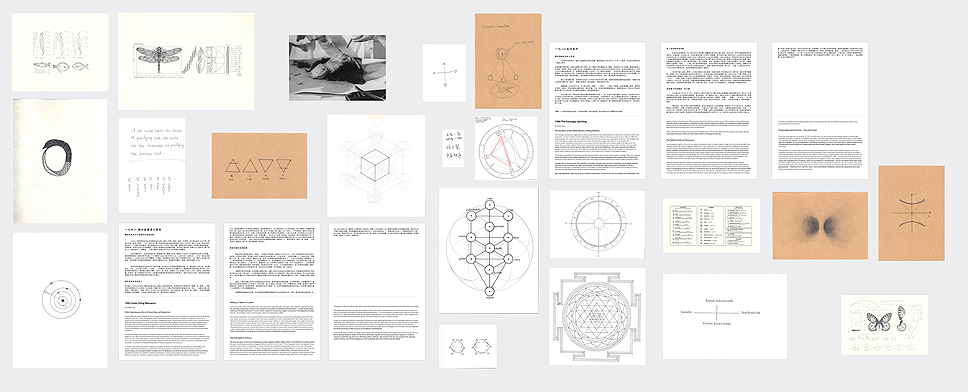
drawing & text collections 2 | pencil, ink, photocopies | size varied | 2014
事件占星解讀與其它相關文件
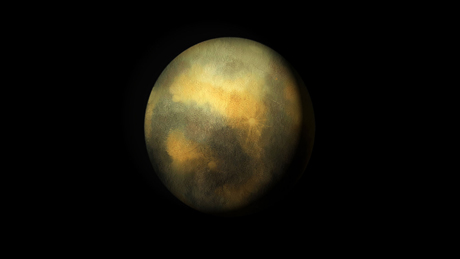 Pluto | HD video | loop | source: NASA | 2014 |
 Mars | HD video | loop | source: NASA | 2014 |
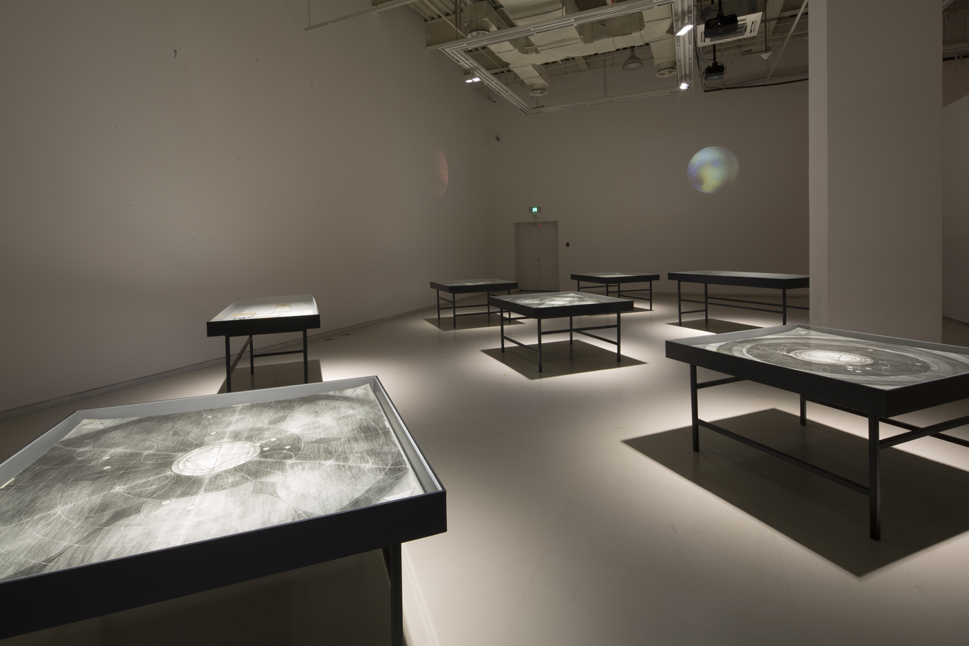 Photo by Power Station of Art, Shanghai, CN | 上海當代藝術博物館 |
|
 |
 |
2021 Notes on Psychedelics III: 2-19-20 //// 2018-2020/ Sonic Driving //// 2018/ Reverberation of the Pleiades //// 2018/ Extrastellar Evaluations III : Entropy : 25800 //// 2016/ Extrastellar Evaluations //// 2015/ Notes on Psychedelics //// 2015/ Action at a Distance //// 2014/ Liquidation Maps //// 2013-2014/ As Above, So Below //// 2012/ One Universe, One God, One Nation //// 2011/ The Turner Archives

 《天一象、地一物》 As Above, So Below
《天一象、地一物》 As Above, So Below
2013-2014Mixed media/ 2-channel video installation
Drawings | Video#1: 6 min | Video#2: 40 sec | loop | sound | B&W & Color
 |
 |
This is the first phase of Chen's recent artistic practice from a long running project – As Above, so Below. Based on her recent operation and its accompanying medical issues, Yin-Ju Chen is embracing science and pseudoscience, and exploring Paracelsus' idea of the mystery of the macrocosm (nature) and the microcosm (human).
This practice is an extension of themes from her previous project as a continuing exploration of the notion of "cosmic/ human connectedness." Here the initial focus will be on the human body before widening the view onto the infinite cosmos.
As Above, so Below is presenting as a video installation, supplemented with printings and drawings.
This ongoing project integrates cosmology vs. astrology and modern medicine vs. alchemy, to discuss of the ideas of perfection, transformation, and the relationship between humanity and the cosmos.
這件作品是一系列討論何為完美、淨化、轉換的創作計劃之序曲。 《天一象、地一物》是由個人的醫療經驗出發,綜合科學與偽科學、中世紀瑞士醫生帕拉塞爾斯(Paracelsus)對於大宇宙(自然)和小宇宙(人類)的思考,如宇宙學/占星術、現代醫學/鍊金術,繼續探索宇宙與人類之間的神秘關聯。

 共登世界大同之境
共登世界大同之境
 One Universe, One God, One Nation
One Universe, One God, One Nation
2012
3 channel video installation | 17 minutes loop | color & B/W | stereo

Channel 2 and 3 | Left: Sun | Right: Scorpio constellation

Channel 2 and 3 | Left: The crowd cheering Chiang Kai-Shek | Right: Chiang Kai-Shek waving to the people
Yin-Ju Chen's new video installation One Universe, One God, One Nation seeks to evoke a sense of closure and despair in the face of the inescapable cycles of history. The particular moment evoked here is the age of space exploration in the 1960s, juxtaposed with the forms of imperial, ideological, and totalitarian power existing at that time. The inspiration for the work came from Hannah Arendt's analysis of space exploration as a form of "world alienation," and also from the astrological horoscope of Chang Kai-Shek, which predicts his charismatic and authoritarian character. How is it that most modern movements for a better future, and all attempts to break free from the chains of power, ultimately fall prey to their own mythologies? Here we enter the slippery ground between "science" and "collective dream image," between the knowledge and the fantasy of an epoch. One Universe, One God, One Nation is a visual meditation on power, modern forms of totality and totalitarianism, mass mobilization, devotion, the auratic, and the supernatural. It works through the juxtaposition of images taken in outer space with images of war and submission to power.
Text source: Taipei Biennial 2012
陳瀅如的錄像裝置新作《共登世界大同之境》則試圖喚起在面對歷史循環和無法逃脫的事物之際,人們的幽閉和絕望感。這件作品提及的特定時刻是太空探險的1960年代,並同時涉及當時存在的帝國主義形式、意識形態的和極權統治的權力。作品的靈感來自漢娜.阿倫特(Hannah Arendt)對太空探險的分析,阿倫特認為太空探險是「世界異化」的一個形式,以及蔣介石的星座分析中關於他的領袖特質和獨裁性格的預言。為什麼許多朝著更美好的未來邁進的現代化努力,以及突破權力枷鎖的所有企圖,都在最後淪為它們所製造的神話的犧牲者?在此,我們在此踏上了「科學」和「集體夢境的畫面」之間、介於一個時代之知識和幻想之間的不穩定地帶。《共登世界大同之境》從視覺上思索權力、總體和極權主義的現代形式、大規模動員、效忠、氛圍式的和超自然的事物,在呈現上則運用了將外太空拍攝的畫面和戰爭、屈服於強權及效忠的畫面兩相並置的手法。
文/2012台北雙年展
 Channel 1 is showing before entering the exhibition room of Channels 2 & 3. It shows one image of Pluto and its astrological interpretation. |
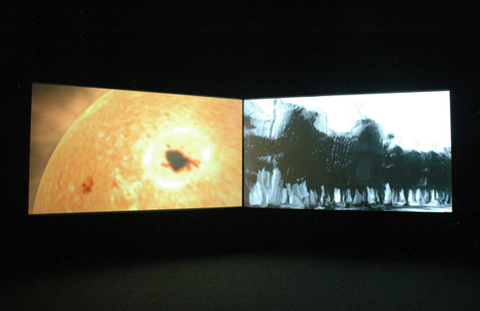 Installation view | Channel 2 & 3 5 min excerpt |

 透納檔案 The Turner Archives
透納檔案 The Turner Archives
By Yin-Ju Chen & James T. HongMultimedia/ 2-channel video installation | Numerous displayed objects | Video Channel 1 & 2: approx. 5-minute loop | Sound: 20 minute loop | 2011
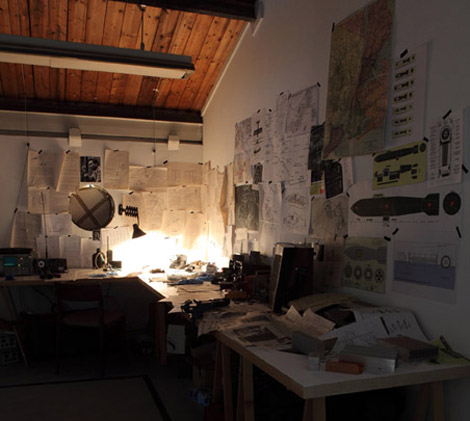 |
 *Photos: Willem Vermaase/ RijksakademieOPEN 2011 |
This work functions as a critique through the process of "over-identification" with a particular ideological perspective. It presents a perfect and yet dangerous opportunity to meditate on ugly, racist ideological themes, while at the same time illuminatingly present racial conflicts within the United States and the developed West vis-à-vis immigration, terrorism, and ethnic nationalism. Hopefully this project will shed light on the racist prejudgments we "always already" understand.
This work presents the world of a fictional, American white supremacist named Earl Turner. Trained as an electrical engineer, Turner is a rabid racist who works to overthrow and destroy the multicultural, United States government.
This multimedia installation is presented from Turner's perspective.
His main studio or bunker contains a long table, which displays pieces of Turner's tools, strategies, notes, and thoughts, which are all related to the white supremacist movement depicted in the novel The Turner Diaries (see work concept below), and to historical, racist movements, such as the Ku Klux Klan. The video room presents some of Turner's own film and video footage. On one screen, his lens captures images of racial and ethnic borders, with particular emphasis on the border between California and Mexico, which he sees as broken and needing a permanent solution.
On the second screen, Turner's lens focuses on aspects of American life that Turner hates, such as multiculturalism, people of color, and typical "brain-washed" Americans.
《透納檔案》的靈感來自威廉.路德.皮爾斯(WilliamLuther Pierce)的小說名著《透納日記》(The Turner Diaries)。這部小說被譽為「種族歧視的必讀經典」:小說一開始是種族衝突,並以白人優越主義的勝利作結。這部小說之所以出名,是由於它成為許多種族仇恨犯罪和右翼恐怖攻擊行動的靈感來源。《透納檔案》這件裝置作品中的主角名為「透納」,觀者參觀作品時,即是走進他的私人「戰爭房」或規劃室。在此,觀者看到透納推翻美國政府的個人計畫,以及美國近期通過的反移民法令與三K黨歷史的參考資料。「戰爭房」中有兩件錄像作品,一個呈現種族隔離式建築與美國和墨西哥邊境的畫面,另一個則呈現有關多元種族美國的種種畫面,而這正是透納所要宣戰的對象。
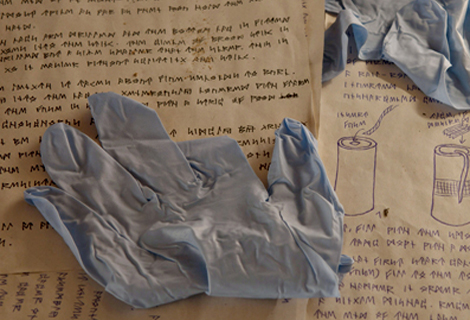 All the notes is written in runic alphabets, to represent white suprematists' ideology. |
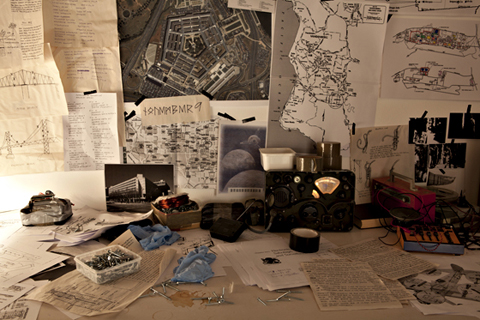 Turner's working table, displaying his equipment, notes, homemade bombs, and attacking plans. |
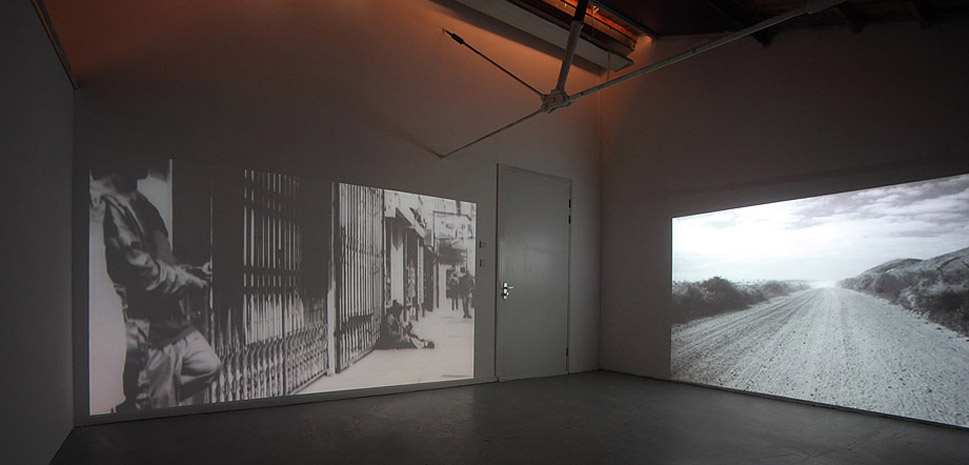
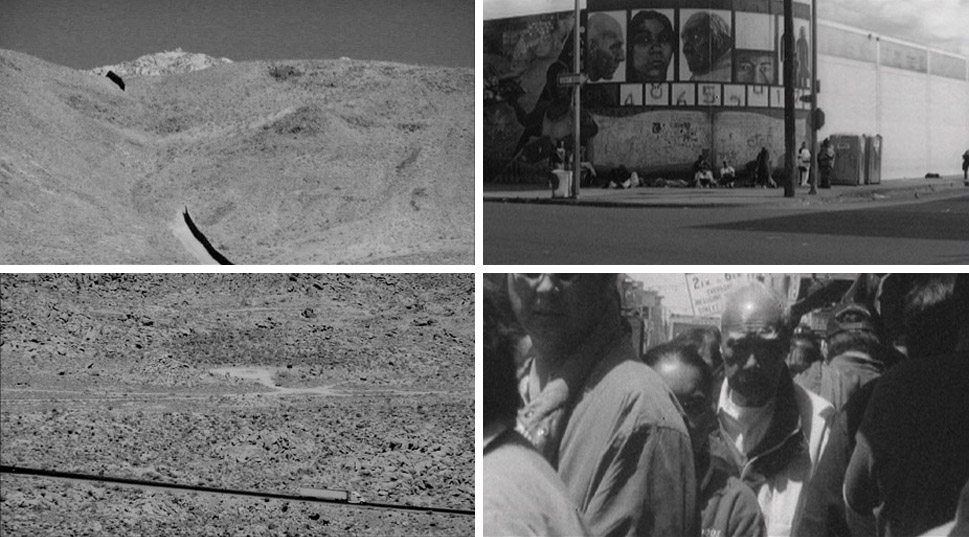
The dual-channel video room
Left: An immense landscape was cut in half by the border. | Right: The aspects of American life that Turner hates, such as multiculturalism, people of color, and typical "brainwashed" Americans.
